best animated feature of the year.”

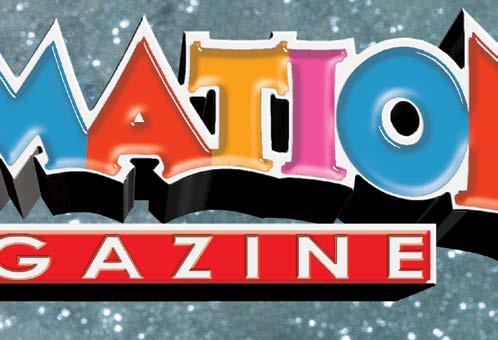
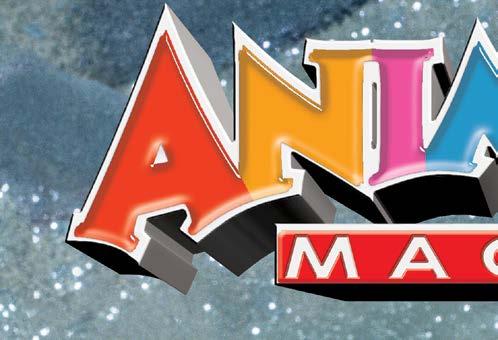





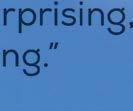















‘THE BOSS BABY ’

(adapted from the 2010 book by author and illustrator Marla Frazee) is a sweet adventure tale about sibling rivalry that ultimately becomes A MOVING TRIBUTE TO FAMILY AND BROTHERHOOD.”



Frame-By-Frame
6 Stuff We Love
8 February Planner
Features
10 Prehistoric Plasticine Perfection
Early Man, the new stop-motion epic from director Nick Park and this team at Bristol-based Aardman Animations, centers on a soccer-playing caveman with a heart of gold.
 By Karen Yossman
By Karen Yossman
14 Studio Ponoc’s First Magical Journey
Director Hiromasa Yonebayashi looks back at the making of his studio’s first movie, Mary and the Witch’s Flower
By Cameron Koller16 How to Make an Indie Angsty Critters Movie
Alberto Vázquez and Pedro Rivero discuss the arduous journey of making their highly original feature Birdboy: The Forgotten Children
By Ramin Zahed20 Oscar’s Short Film Shortlist
The top 10 toons advancing to nomination voting for the 90th Academy Awards Best Animated Short Film race. Five final nominees will be announced January 23.
24 Meet the Final 10 VFX Oscar Contenders
The Academy narrows down the visual effects feature play ers to 10 remarkable titles.
On the Cover: Lionsgate will release Aardman Animations’ highly anticipated new feature Early Man in U.S. theaters on February 16.
26 The Forgotten Crafts
In the past, animated features have often been shut out when it comes to below-the-line awards, but the tide may be turning.
By Karen Idelson29 The Blockbusters of 2017
In case you are keeping tabs, here is the list of the past year’s top 10 animated and vfx-driven movies at the U.S. box office.
30 The Night of a Thousand Toons
The Annie Awards will celebrate another year of brilliant achievements in animation and visual effects by indie art ists and studio teams alike.
32 State of the Art: How Game Engines Shape the Future of Television
The Future Group melds real and virtual worlds in its multi screen game show experience Lost in Time
By Stig Olav Kasin34 Not Your Father’s FBI Show!
Hot Streets Adult Swim’ crazy, off-center new toon, is everything we need this winter.
By Ramin Zahed36 Pink, Positive and Purr-fectly Tooned
Producers Lynn Wang and Ed Skudder share the secrets of Warner Bros. Animation’s brightly colored Unikitty!
By Ramin ZahedEver wonder if you really are best suited as a full-time employee or if your true calling is to venture out on your own? Take this personality quiz and see where you stand. The answer might surprise you!
By Martin GrebingAdobe Creative Cloud makes exciting updates to XD, Character Animator, Lightroom and more.
By Todd Sheridan PerryThe wizards of The Third Floor reveal a few of the secrets of their work on Star Wars: The Last Jedi
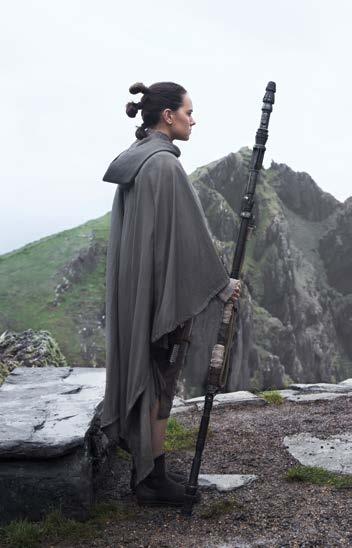 By Trevor Hogg
By Trevor Hogg
Framestore makes Paddington Bear’s second cinematic journey a marmalade-filled feast for the eyes.
By Ramin ZahedFive recent anime movies offer fully realized, complex women as their central figures.
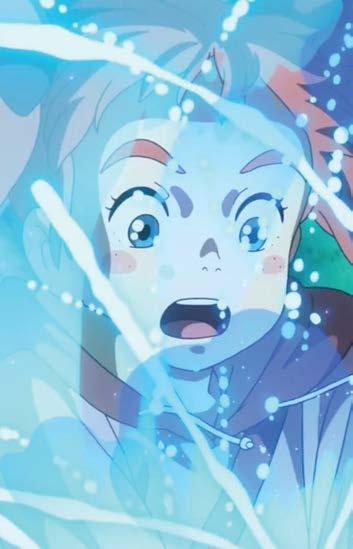 By Charles Solomon
By Charles Solomon
The U.K.-based illustrator/animator discusses his short Happiness, a meditation on the modern rat-race.
As we embark on an unpredictable new year, there are all kinds of seismic changes happening in the global enter tainment landscape around us. Perhaps none will make as big an impact as Disney’s purchase of the majority of 21st Century Fox’s assets for around $52.4 billion. Industry observers have pointed out that this acquisition will have ramifications far pop ular franchises such as The Simpsons, Fam ily Guy, Bob’s Burgers, X-Men, Ice Age and Avatar, all coming under the rule of Mickey’s kingdom.
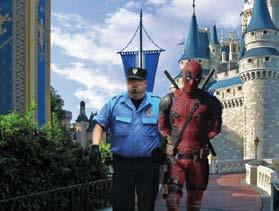
This also means that Blue Sky Studios, the animation producer behind Carlos Saldanha’s recent feature Ferdinand and all the Ice Age movies, may need to realign itself with another distributor since the Mouse House already has the Disney Animation and Pixar titles competing for audience attention. When there are only five major studios left controlling the key entertainment options of the country, there will be less opportunities for animated content from a wide variety of sources. Welcome to a bland new world of fewer options and more push for mass appeal. Analysts are also predicting that 5,000 to 10,000 jobs will likely be lost as a result of the Disney-Fox deal.
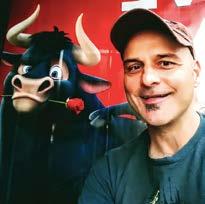
We got another shock to the system last month when the U.S. Federal Communications Commission approved a measure to remove net neutrality rules, which barred internet pro vides from creating priced tiers. The new rules allow ISPS to block or prioritize content at will, throttle traffic and upsell digital fast lanes. If this moves forward, large companies will be able to manipulate consumer access to content, thereby directly affecting how smaller animation, vfx and gaming outfits distribute their content. We will be watching this one closely, because it can have major implications on everyone who loves and works in the animation and vfx business.
For now, let’s enjoy all the glorious animated films, TV shows and digital content that are heading our way in the next few months. We have prepared fun behind-the-scenes stories on Aardman’s much anticipated Stone Age romp Early Man, GKIDS’ Birdboy: The Forgot ten Children and Mary and the Witch’s Flower, Star Wars: The Last Jedi, Paddington 2, Cartoon Network’s Unikitty!, Adult Swim’s Hot Streets and a lot more in this issue.
Who knows what crazy events and life-changing new animated projects will rock our world in 2018? But doesn’t it just boggle the mind that Anastasia (from the Fox animated 1997 movie), Neytiri (the tree clan princess from Avatar) and the slimy mother alien from James Cameron’s Aliens are all now Disney princesses?
Happy New Year!
February 2018
Vol. 32, Issue 2, No. 277
Info@animationmagazine.net
President and Publisher: Jean Thoren
Accounting: Jan Bayouth
edit@animationmagazine.net

Editor in Chief: Ramin Zahed

Multimedia Editor: Mercedes Milligan
Webmaster: Steven Dietrich
Asst. Webmaster: Matthew Keable
Tech Reviews Editor: Todd Sheridan Perry
Contributors: Martin Grebing, Bob Harper, Trevor Hogg, Karen Idelson, Stig Olav Kasin, Cameron Koller, Charles Solomon, Karen Yossman
Sheri Shelton
EVENTS
Kim Derevlany
Director/Production Manager: Susanne Rector
Director: Jan Bayouth
TO ADVERTISE:
818-883-2884
818-883-3773
sales@animationmagazine.net
www.animationmagazine.net


›› The Art of Star Wars: The Last Jedi [Abrams, $40] Lucasfilm collaborator Phil Szostak returns to the author’s desk, having penned the Force Awakens art book, to take readers behind the scenes of the latest Skywalker Saga install ment. Dive into the amazing landscapes, characters, costumes and storyboards created by the studio’s talented “visualists” to bring writer-director Rian Johnson and production designer Rick Heinrichs’ vision to life in this 256-page hardcover, packed with imagery and insights from the crew. #TeamReyAllTheWay.
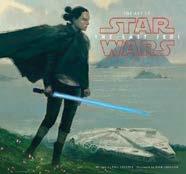
›› They Drew as They Pleased: The Hidden Art of Disney’s Late Golden Age (The 1940s Pt. 2) [Chronicle, $45] The third volume of author Didier Ghez’s must-have series is a rich source of artistic inspiration as well as historic insight into the studio’s great creative minds. This era saw the growth of Disney’s in-house concept and character develop ment through productions like Peter Pan, Fantasia and Dumbo. Andreas Deja penned the foreword.

›› My Little Pony: The Movie [Lionsgate, $30 | $40 BD] The Mane 6 embark on an amazing feature adventure beyond Equestria and encounter new (celeb-voiced) friends and foes. Ponies, mer-ponies, plenty of bonus material and Taye Diggs crooning – what’s not to love? [Jan. 9]

›› The Pink Panther Cartoon Collection, Vol. 1 [Kino Lorber, $20 | $30 BD] De Patie-Freleng’s ultimate hep cat brings ‘60s suave home in 20 HD mastered cartoons with original audio (no laugh tracks!) and select commentary, plus archival sound bites of Friz. [Jan. 30]

››
The Art of Overwatch [Dark Horse, $50] The Blizzard wizards crafted another smash-hit with the popular brawler game and its character-driven animated shorts. Available as a colorful hardcover or digitally through Kindle and Comixol ogy, the 368-page tome illustrates the creation process with never-be fore-seen artwork, character details and artist insights, assembled with the help of the development team.
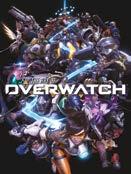
››
Get your graphic novel fix with the complete manga box set for Yoshitoki Oima’s A Silent Voice [Kodansha, $77], hardcover horror compendium Shiver: Junji Ito Selected Stories [VIZ, $23], or go classic with Peanuts Every Sunday 19711975 [Fantagraphics, $50]. For insight on the artform, pick up scholar Hillary Chute’s Why Comics? From Underground to Everywhere [Harper, $40], which explores impact of the medium and its handling of themes from disasters (Art Spiegelman’s Maus) to suburban struggles (Chris Ware’s Jimmy Corrigan) to punk subculture.



›› Loving Vincent [Cinedigm, $20 | $25 BD] The award-winning, groundbreaking painted animation project retracing the last days of Van Gogh’s life comes home, with fascinating behind-the-scenes featurettes and cast interviews that offer further insight into Dorota Kobiela and Hugh Welchman’s labor of love. [Jan. 16]

››
Napping Princess [Shout! Factory, $17 | $27 BD] Kenji Kamiyama pulls together elements of industrial espionage, sci-fi and fantasy in this mystery adventure set between the real world and a magical dreamscape. Set includes director/cast interviews and more. [Jan. 30]


Sinking into the Sea [Shout! Factory, $17 | $27 BD] A great voice cast (Jason Schwartzman, Reggie Watts, Maya Rudolph) and hypnotizing art from one-man production team Dash Shaw (writer/ director) give this unique JohnHughes-does-di saster-flick a great edge. Includes BTS features, shorts and filmmaker commen tary. [Jan. 23]
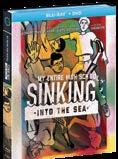
›› January’s anime onslaught includes: Yama da-Kun and the 7 Witches: Complete Series (Funimation, $65); Typhoon Noruda (Sentai Filmworks, $20), Ace Attorney: Objection! (Funimation, $65), Berserk: S1 (Funimation, $85) and Terra Formars S1 (VIZ, $60)


›› Shout! Factory & GKIDS continue their upgraded Studio Ghibli BD rollout with My Neighbors the Yamadas ($20), The Cat Returns ($30) and Whisper of the Heart ($30) on Jan. 16. Meanwhile, VIZ Media has added to its Studio Ghibli picture book catalog with lovely hard-cover retellings of Castle in the Sky ($20) and Princess Mononoke ($30), illustrated with full-color film imagery.





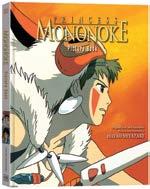
›› Those pop culture junkies at Funko keep ruining our budgets. But how could you resist great Mopeez plushies that let you cuddle up to Cuphead & Mugman, the Five Nights at Freddy’s ter ror-bear (in blue or pink!) or a glow-inthe-dark Black Panther?! Just forward my debt collection calls to Funko HQ.

Animation
››
2017 was a rough year, as headline events showed how far we have to go to create a safe and equitable world. One bright spot is the uptick in fearless female heroes kicking toybox butt. We love the creative concept behind award-win ning brand IAmElemental (Series 2 “Wisdom”
7-figure lunch box set pictured); Hasbro’s line of figures for Star Wars: Forces of Destiny, including Sabine Wren (pictuered), Ahsoka Tano, Leia Organa, Rey and Jyn Erso; DC Super Hero Girls and upcoming Marvel Rising!


›› Regular readers know we’ve been tracking cutie-goth Icelandic brand Tulipop, which has a toon series in development. Good news! Hot Topic launched a collection in stores and online which includes squishable plush toys, apparel and more — like the quite charming Fred Coin Bank ($30, 11” vinyl).

 — Mercedes Milligan
— Mercedes Milligan
Harper is a professional animator who is a creator of a wide variety of


2Julius Onah’s mysterious Cloverfield space-station sequel God Particle will finally be revealed.
12The Children’s Media Conference in Sheffield, U.K. and Kidscreen Summit in Miami both offer three days of learning, sharing and networking for kids’ content pros. [thechildrensmediaconference.com | summit.kidscreen.com/2018]
Check out the latest trends and meet the next big brand at Toy Fair New York [toyfairny.com]
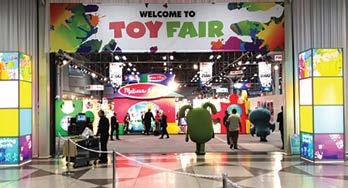
3ASIFA-Hollywood presents the 45th Annie Awards! Coco has the most nominations with lucky 13. [annieawards.org]

The annual Goya Awards also take place tonight in beautiful Madrid. [premiosgoya.com]




9 Beatrix Potter’s famous bunny hops into theaters in
Sony’s hybrid feature Peter Rabbit. Euro co-pro Happy Family sinks its toon teeth into U.S. theaters. Brussels hosts the Anima Festival, presenting nearly 200 shorts, music videos and more. [animafestival.be]

Inventors and developers have their night at the Academy Sci-Tech Awards [oscars.org/sci-tech]
11
Animation and videogame scribes vie with the Writers Guild Awards contenders. [awards.wga.org]
The VES Awards
celebrates the cream of the vfx crop in Beverly Hills. [visualeffectssociety.com]
15Germany’s big Ber linale film confab combines a prestigious festival (opened by Wes Anderson’s Isle of Dogs), co-pro forum and European Film Market. [berlinale.de]
Happy birthday to Matt Groening!

16
Aardman’s highly anticipated Early Man brings Stone Age hijinx to U.S. cinemas. And you’d be a fool to miss the amazing cast, vfx-fueled action and

Find out the British Academy’s favorite animated film at the BAFTA Awards. [awards.bafta.org]


20 Final Oscar Voting opens today! Get your ballots in by Feb. 27.
23
New York Int’l Children’s Film Festival runs through March 18 in the Big Apple. [nyicff.org]

pure visual magic of Marvel’s Black Panther on the big screen.

Legendary cartoonist Tex Avery was born this day in 1908.
To get your company’s events and products listed in this monthly calendar, please e-mail mercedes@animationmagazine.net.

The idea of non-profit corporations is not to keep the money. Six or seven years ago, that was easy for us to do, because we didn’t have any money to keep. But, with your support, today we have discretionary funds, and the best part of this very gratifying growth has been to put those funds back into our community, both locally and worldwide.
Our goal in 2018 is to once again raise the amount we spend on projects outside of the Annie Awards by 15% from $160,000 to at least $185,000 for projects as diverse as the ASIFA Archives, the Animation Educators Forum scholarship and grant programs, the Animation Aid Foundation, our Animation Preservation Project, and the Open Source Support Initiative as well as continuing to sponsor other animation organizations and events. That, and completing and opening our ASIFA-Hollywood Animation Center and June Foray Screening Room, keeps all of us on the ASIFA board focused squarely on our mission.
Frankly, without your help and support through memberships and individual and corporate sponsorships none of this would be possible.
It has always been a dream for ASIFA to be able to do all of these things. We hope, at least in some small part, our work can be part of your dream too.
For more information on ASIFA-Hollywood, the worlds largest animation society, please visit asifa-hollywood.org

Early Man, the new stop-motion epic from director Nick Park and this team at Bristol-based Aardman Animations, centers on a soccer-playing caveman with a heart of gold.
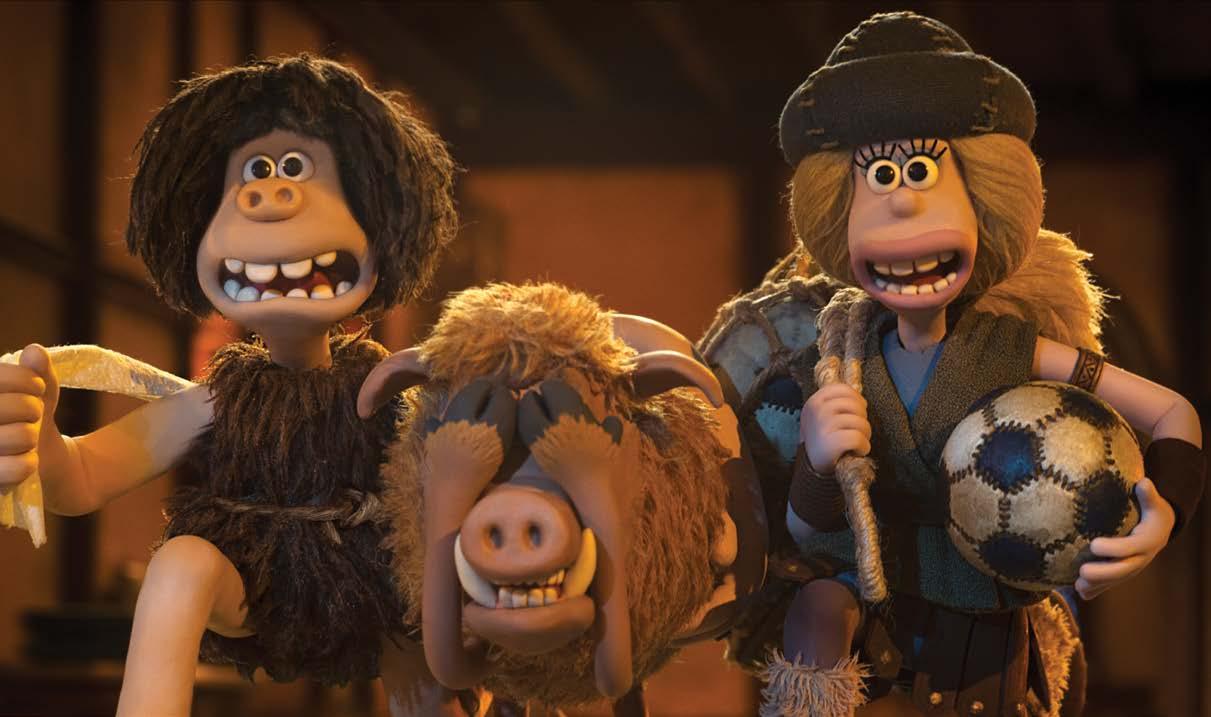 By Karen Yossman
By Karen Yossman
In a cinematic landscape dominated by se quels and superheroes (especially superhe ro sequels), subjects like soccer and cave men rarely crop up on the big screen anymore. But Early Man, an upcoming stop-motion fea ture about soccer-play ing cavemen from British studio Aardman Anima tions, may be about to change all of that.
The brainchild of Wal lace & Gromit creator Nick Park, Early Man is a classic underdog caper featuring an enthusiastic caveman called Dug (voiced by Academy Award-winner Eddie

Redmayne) who must learn to play soccer — or, in British parlance, “football” — in order to save his tribe from the dastardly intentions of the Bronze Age army and their nefarious lead er, Lord Nooth (a French-accented Tom Hid
‘There’s much more of a mixture of clay, puppet animation and digital backgrounds, and also the fact that so much of a part of the story happens in a stadium … How to make that and marry those two worlds together so they work?’
dleston). Despite being technically arduous to capture in stop-motion, soccer was deliberate ly chosen by Park over other sports, in part because of the intense devotion it inspires across the world (especially in Britain), which meant it worked neatly as a metaphor for war. “I think originally it was just the idea of cavemen with their clubs,” he says of his inspiration for the wholly original plot, which he first conceived almost a decade ago.
“What if they can’t use their brute force and their clubs and weapons and spears, and have to
Discipline is a subject Park knows plenty about, given that his forte is clay stop-motion, an art form demanding the utmost in patience and diligence. The Early Man crew included around 35 animators, each painstakingly pro ducing around five seconds of footage a week.

“With that many animators, it clocks up. A week can be a minute of animation,” Park says, adding with a chuckle: “That’s storming through it!”
For Redmayne, who visited the set in Bristol last year alongside co-star Maisie Williams, watching the crew animate the puppets — which are made from a mixture of plasticine and silicone on a wire ball-and-joint armature

— was “absolutely spectacular.” “It’s like a magical world and your inner nine-year old is having the greatest time of his life,” he gushed of the experience. “I also felt overwhelming guilt because, as the actors in animated films, over 18 months you do a day’s work every month or something, and then you realize how much work goes into bringing to life the bit you’ve been doing.”
Williams, a long-term Aardman fan who cites Chicken Run as one of her all-time favor ite films, was equally blown away by the expe rience. “It’s just incredible, the work and the amount of people that it takes to make one movie,” she says. As with most animated fea tures, Williams and Redmayne recorded most of their dialogue separately, although they took the opportunity of their joint set visit to jump
into the studio’s live-action video unit — where Park can usually be found acting out the script as a guide for his animators — to record some scenes together. “We needed to get a bit method,” Redmayne quips. “Get in there and get a bit in character. They encouraged me to kick a football, but I thought for the sake of everyone’s health that was a really bad idea.”
“I really think the scenes we did together ended up being some of my best,” says Wil liams, who provides the voice of Goona, a gift ed athlete prevented from playing soccer pro fessionally because she’s a woman. “Because [Eddie] really brought a lot of character out of me that I was quite nervous and scared to do.” Best known for playing Arya Stark on Games of Thrones, voicing an animated character repre sented a new challenge for the actress. “I just

Merry Misfits: Early Man has been in the works for many years. “I saw a sketch for this the other day that was dated 2011,” says Nick Park. “We spent a long time talking about it and writing.”
‘I would say the only major difference is that we shoot digitally rather than on film, because the processes are very much the same as they have been right from when Nick Park was starting on his Wallace & Gromit adventures.’
had fun with it, really,” she says. “Nick’s way of working was so different to anything I’d ever done before because of the nature of the job and using only your voice and no facial expres sions or body movement. It’s very different.”
To some extent, Early Man was an entirely new experience for Park, too. While he has previously directed animated clay features such as Oscar winner Wallace & Gromit: The Curse of the Were-Rabbit and Chicken Run, the ambitious scale of Early Man presented fresh challenges. “That’s what’s exciting,” he says. “Both exciting and challenging — it’s a
whole new world.”
Early Man is Park’s first film since Wallace & Gromit to feature a human protagonist and, as well as introducing the audience to a whole cast of new characters, the crew needed to create vast landscapes, backdrops and set pieces on a far bigger scale than Park’s previ ous films had necessitated. One of Early Man’s largest sets, the soccer stadium, tow ers over the animators at almost 10 feet tall and features a mesmerizing plethora of detail, such as soccer ball motifs in the ground and on the building, which many viewers probably won’t even notice but gives the set a depth and richness.


Then, of course, there are the technical as pects of trying to shoot a stop-motion feature about soccer, a sport which requires 22 play ers on the pitch, tens of thousands of fans in the bleachers, and a ball continuously being kicked to and fro, all of which needs to be cap tured one frame at a time. “Funnily enough, the bouncing ball is one of the tests that many an imators will do very early in their career,” says animation director Will Becher wryly. “Which is something you don’t think you’re ever going to use.” Fortunately, the Early Man crew included an industrious rigging department, who were tasked with everything from making soccer balls fly through the air to supporting ar mor-clad mammoths so mammoth they re quired scaffolding.
“There’s much more of a mixture of clay, puppet animation and digital backgrounds, and also the fact that so much of a part of the story happens in a stadium,” Park agrees. “How to make that and marry those two worlds together so they work? And there are lots of technical restrictions.”
Other than swapping out painted cloth
— Supervising art director Richard Edmunds
backdrops for greenscreens, however, Aard man’s methods have hardly changed in the 41 years since the studio’s incep tion. “I would say the only major difference is that we shoot digitally rather than on film,” says supervising art director Richard Ed munds. “Because the pro cesses are very much the same as they have been right through [from] when Nick Park was starting on his Wallace & Gromit adventures, and Morph [created by Aardman co-founder Peter Lord] with his plasticine, he’s still made exactly the way he was 40 years ago.”
What makes Aardman’s commitment to clay all the more extraordinary is that in addition to the labor-intensive nature of stop-motion pro duction, which requires each puppet to be mi cro-adjusted multiple times per shot, there are the very practical challenges of working with the material. “The plasticine has a tendency to pick up dirt and dust,” explains Nigel Leach,
team leader of the puppet-making department. “It’s a constant process of renewing the mouth sets and repairing the heads whenever it’s needed.”
But for Park, who calls himself a “clay man” at heart, getting his hands dirty is one of the best things about working with plasticine. “I love the texture and don’t apologize at all for the fingerprints and the boiling fur that you get,” he says. “It’s all part of the charm.”
StudioCanal releases Early Man in the U.K. on January 26. Lionsgate will open the film in the U.S. on February 16.

“O
ne of my heroes is Ray Harry hausen. And there are several references to One Million Years B.C. and some of his other movies in Early Man. In fact, there are two dinosaurs in the beginning of the film that we have named Ray and Harry as a tribute. We have other references as well: There’s a very notional nod to Die Hard with jump ing out the window with toilet paper rather than a hosepipe. I mean, I watched a lot of sports movie which are all about the underdog or a team who has to win something back against all odds — movies like The Bad News Bears (1976) and Miracle (2004). Lagaan: Once Upon a Time in India (2001) was also a big one, it actu ally has a similar model.”
— Nick Park
Director Hiromasa Yonebayashi looks back at the making of his studio’s first movie, Mary and the Witch’s Flower.
When Studio Ghibli announced the shuttering of its production facilities in 2014, the shockwave sent through the animation world was powerful. Arguably the most critically respected and influential animation studio in modern history, certainly the flagship stu dio of the anime industry, it seemed a huge hole would be left in the animation world. This shock was undercut two years later when Ghibli’s famed co-founder Hayao Miyazaki announced his return to filmmaking, but nonetheless the days of the be loved Ghibli style seemed numbered. Yet, the stu dio’s seasoned team of animators weren’t ready to retire the tradition. For that reason, we now have Studio Ponoc and its debut fantasy feature, Mary and the Witch’s Flower
Based on the 1971 British novel The Little Broomstock by Mary Stewart, Mary and the Witch’s Flower depicts the story of an insecure young girl who stumbles across a rare flower in the woods that gives her magic abilities and opens a portal in the sky to a parallel world of a university for witches. However, she soon discov ers this school holds a dark secret and finds her self in a fight for her life.
By Cameron KollerMary wears its Ghibli roots on its sleeve, for good reason. Director Hiromasa Yonebayashi has ani mated on Ghibli features since 1997’s Princess Mononoke and directed The Secret World of Ar ietty and When Marnie Was There for the studio. He had been enamored of Ghibli’s craftsmanship before he went to work for them. In an email inter view, he tell us, “I wanted to become a profes sional animator after watching Studio Ghibli’s Whisper of the Heart. The energy and enthusi asm of the young Studio Ghibli staff members involved in making that film made me want to cre ate animation there.”
As an animator, he was responsible for scenes such as Sophie and Howl’s first meeting in
‘In today’s modern world, where we are strongly influenced by invisible things like fear and rumor, we think it is meaningful to depict a story that deals with solving problems without the use of magic.’
— Director Hiromasa YonebayashiAfter working on When Marnie Was There, which the director describes as a relatively quiet film, he says he wanted his next film to have lots of action scenes featuring a totally opposite charac ter who was full of energy. “Producer Yoshiaki Nishimura and I came upon The Little Broomstick after searching through and reading lots of books,” he notes. “There are many stories of magical pow ers in which problems are solved using magic, but in this story the heroine rejects magic and tries to solve problems with her own strength. In today’s modern world, where we are strongly influenced by invisible things like fear and rumor, we think it is meaningful to depict a story that deals with solving problems without the use of magic.”
From the action-packed opening moments,
Howl’s Moving Castle and the giant fish tsunami in Ponyo. According to Yonebayashi, it was his work on Ponyo that convinced Miyazaki to put him on Arietty, a huge gamble for a studio essen tially synonymous with its elder star directors Mi yazaki and Isao Takahata.

Yonebayashi’s part ner in crime in establish ing Ponoc was former Ghibli producer Yoshia ki Nishimura, with whom he had collaborated on Marnie. While Nishimu ra only had two produc er credits (The Tale of the Princess Kaguya and When Marnie Was There), he had five years of experience prior to production in legal and advertising roles at Ghibli.
Like Yonebayashi, he connected to The Little Broomstick as a story of a realistic character tri umphing over adversity without magic as some

thing that could be inspirational to young viewers. He says the quote from the novel that spoke to him most directly reads: “… Magic isn’t fair … I’ll do it the way it’s used to, even if it does take lon ger.” With that unifying story theme in mind, they duo went to work.
Of course, attempting to make a Ghibli-quality film without any of the Ghibli cultural capital proved far from easy. When Nishimura and Yone bayashi visited USC a few months ago, they relat ed some harsh figures. Over the course of the film’s two-and-a-half-year production, a team that began with two to three animators grew to 450. It proved a hugely difficult enterprise for an anima tion studio that began life without even a home base. As Yonebayashi noted, “We [me, Nishimu ra, and co-writer Riko Sakaguchi] put our heads together in discussions on the script with an enormous number of drawings, going from one café to another, as we had no office back then.”
The team went from the best-funded studio in Japan to having to start from scratch without any of the software, hardware or servers they had had access to. Funding had to be acquired without the boon of the Studio Ghibli brand name. Nishimura went to previous investors on his last two features to try and acquire the necessary resources. Though it was a hurdle, he was very familiar with working on difficult productions as a producer on The Tale of Princess Kaguya. He notes, “The pro duction was particularly full of difficulties which led to delays and interruptions, and even the risk of funding being withdrawn.” Thankfully for Nishimura, his investors shared his vision of con
tinuing to create hand-drawn features in the style of Ghibli, and they wrangled up the needed funds
Watching Mary, that devotion to the Ghibli style is on full display with every gorgeously ren dered frame. Even more so than Yonebayashi’s movies at Ghibli, it visually quotes the entire his tory of Ghibli, from the opening scenes with its bizarre creatures and dizzying heights that evoke Laputa: Castle in the Sky and Nausicaä, to the serene depictions of Mary’s everyday life that evoke My Neighbor Totoro and Isao Takahata’s Only Yesterday. Not to speak of the gobs of for mer Ghibli talent lurking in the animator credits.
Atsuko Tanaka, Masashi Ando, Shinji Otsuka and others lend their talents to the production. Shinya Ohira, who was responsible for the boiler room scene in Spirited Away, here conducts a climac tic transformation sequence that seeks to one-up his past efforts for Ghibli.
In addition, veteran character designer Akihiko Ya mashita, who also provided character designs for Arietty and Howl, contributes designs that evoke the entire history of Ghibli, including one broom-wran gling mouse by the name of Flanagan, who evokes Miyazaki’s anthropomorphized characters for Sher lock Hound. If you’ve watched a lot of Ghibli, the film almost seems like a remix of past images.
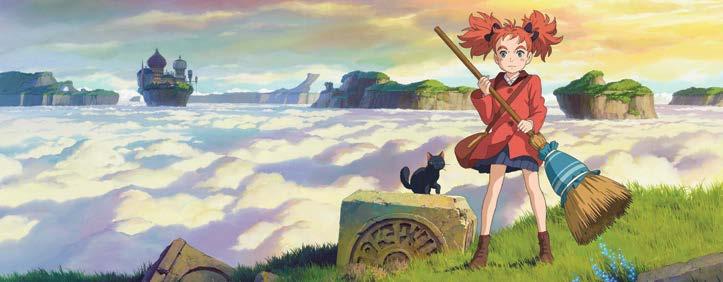
It’s hard not to read an allegorical component to Mary and the Witch’s Flower. In some ways Mary’s journey to find strength without magic echoes Ponoc’s quest to establish itself without the aid of the Ghibli brand. Ponoc has one foot in the past and one foot in the future as a brand new animation studio with some of the best in the in dustry throwing their weight behind it.
“I aim to run a studio that allows creators the stability to focus on their creative work by com pensating them appropriately for their creativity,” says Nishimura. “On this point, it is the same as at Studio Ghibli. As a new company that is just starting out, we are of course beset by funding issues, but I want to make sure to implement this policy.” Nishimura also stresses intentions to col laborate internationally on future productions, both to address financing issues and to stylisti cally distinguish Ponoc from the more insular Ghibli. He adds, “To raise an idea that is different from what we had at Studio Ghibli, at Studio Ponoc we plan to engage proactively with inter national co-productions and co-financing as a way of collaborating outside of Japan.”
Ponoc even utilized its own English-language dub expert in concert with U.S. distributor GK IDS in the film’s western localization. If they con tinue plans to turn Ponoc into an international studio, it will join other anime studios like Masaaki Yuasa’s Science Saru and Studio Trigger who have made use of western crowdfunding meth ods and worked on western properties. Like Mary, each of these studios found themselves without the magic of their former brands striving to make their own name for themselves.
One quote from Miyazaki sticks with Yone bayashi: “One film can change the world.” Time will tell if Mary and the Witch’s Flower, excellent studio debut though it may be, will change the world, but Ponoc will certainly strive to balance the need to preserve the past with the need to transform with the passage of time.


Alberto Vázquez and Pedro Rivero discuss the arduous journey of making their highly original feature Birdboy: The Forgotten Children.
By Ramin ZahedIt would be quite an understatement to say that Alberto Vázquez and Pedro Rivero’s ac claimed Birdboy: The Forgotten Children is unlike any movie you will see this year. After all, how many films — animated or otherwise — center on the misadventures of cute critters dealing with issues such as murder, depres sion, environmental disasters and general exis tential angst?
The movie, which is based on Vázquez’s Spanish graphic novel Psychonauts, was re leased in Europe in 2015, but it’s finally getting its U.S. theatrical run this year thanks to GK IDS. As Vázquez tells us in an email interview, it has been a long and amazing 10-year journey.

“Years ago, I was very involved in my work as an illustrator and comic artist,” he recalls. “One day I received an email from Pedro [Riv ero] telling me that he liked my comic very much and would like to develop it into an ani mated project. So we decided to work togeth er on a short film first, which became the 2011 short Birdboy. We won some prizes, traveled around the world and ended up finding pro ducers who were interested on developing it into a movie.”
“In May 2014 we started the production of
the movie itself with a team that never exceed ed 15 people,” says Rivero. “It took us about a year to complete the movie. Then, with some interruptions, in the following four months all the post-production and sound details were finished, and we were able to present the final version at the San Sebastian festival in Sep tember 2015.”
The film’s traditional animation was pro duced by the team at Abrakan Studio, using Flash and Photoshop (to create lighting and textures). Vázquez says the creative team de
veloped its own system without really looking at how other productions and studios worked.
“It was a small team,” notes Rivero. “We had eight animators and four artists for the back grounds (including Alberto), with some final reinforcements for the lighting.”

Vázquez and Rivero wanted to strike a deli cate balance between the look of the classical “cute” designs for children with a sophisticat ed art direction that expressed the demons of
‘People from very different places in the world have told me that they have identified with the film and that it reminded them of moments in their own life. That’s why I still have the energy to do more projects!’
— Director Alberto Vázquez
the characters.
“Psiconautas (the original Spanish title for Birdboy: The Forgotten Children) is a meta phor for adolescence,” adds Vázquez. “All the characters are children or adolescents who want to escape the world of adults, which means repression and authority. Some pre tend to escape physically and others mentally by using drugs — hence the original title, which means travelers of the mind. I drew this comic when I was very young, so I used only the things I had lived through — with all my limita tions. I was expressing the only one I knew about my life: adoles cence!”
Another inspiration from the artist’s home town region of Galicia, which was the gateway for heroin in Spain during the 1980s. “It is a rainy area where the fishing in dustry is the economic engine,” he explains. “You can see the parallels to where the protagonists of Psiconautas live. I took many things and places that I know but set it all in a fantasy world, starring anthropo morphic animals. The story incorporates many of our modern problems: drugs, pollution, un employment, family, religion … but everything is mixed with fantastic elements, such as de mons, talking objects, hallucinations, etc.”
Looking back, both directors believe the film’s low budget (estimated to be about one million euros) was their biggest challenge. “I remember being quite exhausted because, in addition to managing the project, I had to work on the art direction, backgrounds, storyboard,
etc.” says Vázquez. “The team was small, and our deadlines had to be adjusted, so we all had to do many things. If you see the credits of the movie you will notice that!”
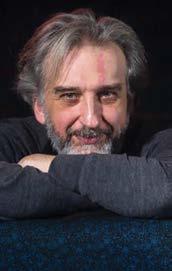
Now that the film has moved beyond the festival circuits and is being seen by a wider audience worldwide, the directors are quite pleased with the results.
“Personally, I am very happy to see this story that was so personal and special to me is now being seen in several countries as an animated
scene in his home country, Rivero says there is a clear distinction between two types of proj ects. “We have a group of artists who do great technical and expressive work in the field of short films. Then, there are more commercial ly-minded producers who like to make big pro ductions with huge budgets to emulate the success of the American studios,” says the di rector. “There is only a very small space for productions such as Birdboy. ”
Of course, the movie has opened more doors for the two creative artists. Rivero is working on several new scripts, and is devel oping a new animated project titled Meteor, which will once again feature animals in a dys topian world. Vázquez followed up Birdboy with the much-admired short Decorado last year, and is now busy with a new movie called Unicorn Wars, which details the fantastic war between bears and unicorns in a magical forest (based on his short Unicorn Blood).
film,” notes Vázquez. “I consider myself lucky to have done this and to have such an amazing team that worked hard to create a worthy film, despite all the difficulties we faced.”
“I feel above all that we made the fortunate decision to realize the potential of this graphic novel,” says Rivero. “I believe that this has been — and will probably be in many ways — one of the most remarkable and courageous experiences that Alberto and I will have throughout our professional life.”
When asked about the general animation
For now, though, both directors hope audiences will enjoy and be moved by the strange and wonderful world of Birdboy. “I hope they’ll remember and enjoy the movie, and then they can reflect on it later,” says Vázquez. Rivero agrees, “We also hope they’ll realize that animated films can deal with these types of mature and complex stories, which seem so difficult to produce.”


GKIDS released Birdboy: The Forgotten Children in select theaters in the U.S. last month.
‘I believe that this has been — and will probably be — one of the most remarkable and courageous experiences that Alberto and I will have throughout our professional life.’
— Director Pablo RiveroFever Dream: The New York Times called Birdboy “an anthology of nightmares compressed into a picture book.”


The School of Visual Arts has many paths for those who wish to study animation, from undergraduate and graduate programs to continuing education courses. For more information, go to sva.edu.


bfa film & BFA animation offers one of the most immersive and hands-on undergraduate educations for filmmakers and animators in the United States. Whether you study traditional, computer or stop-motion animation, you will be engaged in creating at one of the top art schools in the country.
 Reeves Lehmann, Chair
Reeves Lehmann, Chair

BFA COMPUTER ART, COMPUTER ANIMATION AND VISUAL EFFECTS has a large network of alumni working in major studios, including Pixar, Disney, Dreamworks, Blue Sky, and many more. Other alumni have started their own successful studios, and their work has been included in many festivals.
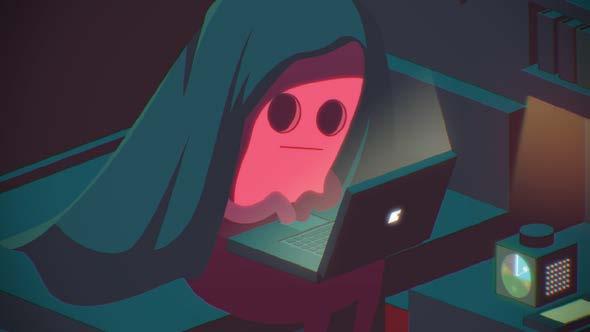

MFA COMPUTER ARTs is the first graduate program in the United States to focus on creating art with computers and new technologies, and it continues to lead the way with its facilities and accomplished faculty. Our network of over 1,000 alumni continue our tradition of excellence as renowned artists, curators and professionals.
Terrence Masson, ChairSVA CONTINUING EDUCATION teaches you to give life and motion to ideas and characters in a program that blends the practical, the theoretical and the creative. Courses offered include fine arts, digital composition, stop-motion animation, storyboarding and special effects.
In December, the Academy of Motion Picture Arts and Sciences announced the titles advancing to nomination voting 10 will be whittled down to five nominees by the Short Films and
Devon Manney, director
Produced By: USC School of Cinematic Arts (U.S.)
Qualifying Win: Student Academy Award (Silver Medal: Animation - Domestic) Official Selections: Aesthetica Film Festival, AnimaSyros Festival, St. Cloud Film Fest 2017 Synopsis: Returning to the U.S.A. after losing

liams. The star-powered short speaks to the game of basketball through Bryant’s gratitude and love for the sport that changed his life. kobebryant.com | glenkeane.com

Robin Joseph, director & producer
Qualifying Release: Theatrical, Los Angeles Awards: Fastnet Film Festival, Oxford Film Festival, ReelAsian Film Festival, Sene Film Festival, VIEW Conference 2016
adventurous amphibians exploring a deserted manor house. The courtship of Frog and Toad milks an impressive amount of characterization out of the film’s photorealistic aesthetics.

Esteban Bravo & Beth David, directors
both arms overseas, a young veteran battles phantom pains, prosthetics, and memories of his pre-war life while reaching for a sense of normalcy. A hint of children’s book illustration and digital-chalk pastels counterbalance the weight of the story. devonmanney.com
Glen Keane, director & Kobe Bryant, writer
Produced By: Gennie Rim; Glen Keane Prod. (U.S.)
Qualifying Release: Theatrical, Los Angeles Official Selection: Tribeca Film Festival Synopsis: L.A. Laker legend Bryant’s inspir ing retirement poem is hand-drawn to life by veteran animator Keane and swelled by stirring music from Oscar-winning composer John Wil
Synopsis: Blending 2D and 3D elements into a rich and painterly digital world, this tale of pursuit and longing follows a curious little fox as he goes in search of an elusive whale. Kim Leow, Joseph’s partner, created the CG character animation while the director handled everything else. patchoforange.com/foxandthewhale
Victor Caire & Gabriel Grapperon, directors
Produced By: MOPA - L’École de la 3D (France)
Additional Directors: Florian Babikian, Vin cent Bayoux, Theophile Dufresne & Lucas Na Qualifying Win: Nashville Film Festival (Ani mated Shorts Grand Jury Prize) Awards: FICCI Frames, Future Film Festi val, Hamburg Animation Award, SICAF, SIG GRAPH Computer Animation Festival, Spark Animation, et al.
Synopsis: Brought to life with impeccable CG animation, the short follows a couple of

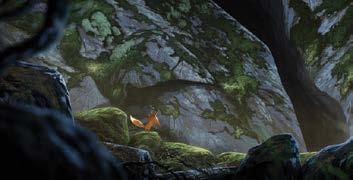
Produced By: Ringling College of Art and Design (U.S.)
Qualifying Win: Student Academy Award (Gold Medal: Animation, Domestic) Awards: European Cinematography Award, HIMPFF, Lake View Int’l Film Festival, Out Here Now, NCGLFF, Trinity Film Festival
Synopsis: A shy, red-haired boy is dragged along a fateful race when his heart literal ly leaps out of his chest to chase down his dreamy crush. A viral smash-hit upon its You Tube release, the short uses bubblegum-bright CG and an all-ages, relatable story about first love with a positive LGBTQ message. inaheartbeat-film.tumblr.com
Chenglin Xie, director
Produced By: China Central Academy of
for the 90th Academy Awards Best Animated Short Film race. Plucked from the 63 submitted qualifying films, the top Feature Animation Branch members, to be announced January 23.
Fine Arts
Qualifying Win: Student Academy Award (Gold Medal: Animation, International) Official Selections: DC Shorts Film Festival, San Francisco Int’l Film Festival, Spike & Mike’s, Sundance Film Festival, Zlin Film Festival
re-appropriate his cherished lost objects and bid his basement post a whimsical farewell. Lostpropertyoffice.com.au
Dave Mullins, director & Dana Murray, producer
Produced By: Pixar Animation Studios
Qualifying Release: Theatrical, with Cars 3 Official Selections: San Francisco Int’l Film Festival, SXSW
Synopsis: It’s the revenge of the smartphone zombies in this darkly comic, refreshingly car toon-y short that explores device distraction accidents. The digital obsession is highlighted by blank textured backgrounds filled only by the objects and people in each character’s im mediate personal bubble. vimeo.com/user48417496
Daniel Agdag, director & Liz Kearney, producer
Produced By: 8th in Line (Australia)
Qualifying Win: Sydney Film Festival (Yoram Gross Animation Award) Awards: AACTA Award, Dendy Awards, Mel bourne Int’l Film Festival
Synopsis: Lou is a collaged creature made up of unclaimed items in a school’s Lost and Found box who collects left-behind objects af ter recess each day. When a bully starts taking other kids’ toys, Lou leaps to their defense –but discovers compassion is better than pun ishment. Composer Christophe Beck (Trolls, Frozen) composed the score. pixar.com/lou
Ru Kuwahata & Max Porter, directors
Produced By: IKKI Films (France)
Qualifying Win: Anima Mundi (Grand Prix) Awards: 3D Wire, Anima Cordoba, Annecy Int’l Animated Film Festival, Busho Film Festi val, Encounters Film Festival, KROK Animation Festival, Pixelatl, Turku Animated Film Festival, et al.

Synopsis: Agdag’s meticulously hand-crafted cardboard world revolves around a thorough and practical man named Ed who manages the Lost Property Office. When Ed realizes he’s been made redundant, he decides to

Synopsis: A dad who is always heading out the door for a business trip teaches his son how to pack a suitcase in this bittersweet, meditative blend of stop-motion and CG ani mation, adapted from Ron Koertge’s original


poem. The directors sought out visceral, tac tile materials to key into their childhood memo ries of sight, sound and touch. ikkifilms.com
Jakob Schuh & Jan Lachauer, directors
Produced By: Magic Light Pictures
Qualifying Release: Theatrical run Awards: Annecy Int’l Animated Film Festival, BAFTA Children’s Award, Shanghai Int’l Film and TV Festival, Banff World Media Festival
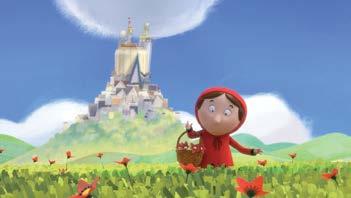
Synopsis: A two-part spoofy special which takes beloved author Roald Dahl’s rhyming re inventions of classic fairytales and reinterprets the classic Quentin Blake illustrations into peppy, charming CG animation. The BBC TV movie features the voices of Rob Brydon, Ber tie Carvel, Gemma Chan, Tamsin Greig, David Walliams, Rose Leslie and more. magiclightpictures.com | triggerfishstu dios.com
The 90th Oscars will be held March 4, 2018 in Hollywood, broadcast live on ABC U.S. and more than 225 territories worldwide. More info at oscar.go.com.


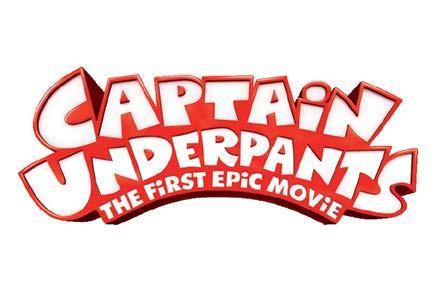
A snapshot of this year’s 10 vfx contenders.
Last month, the Academy of Motion Picture Arts and Sciences selected 10 titles to move forward in the visual effects category for the 90th Academy Awards. These films will partic ipate in the annual “bake-off” in early January, during which the vfx branch will vote to deter mine the nominees. It’s interesting to see less splashy offerings such as Dunkirk and Okja being recognized instead of more predictable fare such as Beauty and the Beast, Pirates of the Caribbean, Wonder Woman and Thor Ragnarok. Nominations for the 90th Oscars will be announced on Jan. 23. The ceremony will be held on March 4 at the Dolby Theatre in Hollywood, and will be televised live on ABC. Here’s a quick breakdown of the big Bake-Off 10 listed in alphabetical order:

Studio: Warner Bros.
Alien: Covenant
Studio: Fox
VFX Houses: MPC, Luma Pictures, Animal Logic, Framestore, Rising Sun, Atomic Fiction, Peerless Camera Co.
VFX Supervisors: Neil Corbould, Vincent Cirelli, Ferran Domenech, Marcus Dryden, Charley Henley, Dan Oliver Highlights: Ridley Scott took the franchise back to the grittier, grungier nature of the original Alien, while continuing with the de sign aesthetics carried through Prometheus. Conor O’Sullivan’s sublime creature designs included a new monster called the Neomorph, which is seen both as a baby and a full-grown alien. Other highlights included some majestic environmental work courtesy of MPC and two landing ships with giant sails. Of course, you got to celebrate the film’s chestburster and facehugger moments, which were much more advanced models of the monsters we first met in 1979.

VFX Houses: Double Negative, MPC, Frame store, Atomic Fiction, Territory Studio, BUF, Rodeo FX, UPP, Weta Workshop VFX Supervisors: Richard Clegg, Paul Lam bert, Viktor Muller, John Nelson, Highlights: Following up the original sci-fi classic’s trail-blazing effects from 1982 was no easy task, but John Nelson and his team did a terrific job of recreating the brave, new world of Ryan Gosling’s officer character, who is in charge of retiring Replicants. Among the dystopian highlights of the movie were the Brutalist architecture of the future cities, the new holographic characters, and an eye-pop ping, digital reproduction of Rachael, Sean Young’s original robotic character who is for ever young, thanks to the seamless vfx work. As Nelson points out, “Instead of throwing a billion things at the viewer, why don’t we throw a hundred things, but have them be really, re ally good?”
Using IMAX and 70mm 5-perf film stock, the film utilized previs for the aerial dogfights. As supervisor Andrew Jackson explained, “We might have one or two real planes in the shot already, do a camera track of the real plane, and animate CG planes into that scene un til we were happy with the action.” The film makers also used CG for crowd extensions, environmental cleanup for the water (the ocean-based shots were filmed in Holland in the Zuiderzee inland sea), adding horizon lines and smoke effects, and making adjustments to sand dunes.
Studio: Warner Bros.
VFX House: Double Negative
VFX Supervisors: Andrew Jackson, Andrew Lockley, Tim McGovern, Paul Corbould Highlights: Christopher Nolan’s epic WWII movie received high marks for its “you’re-there” realism, and relied mostly on optical effects to recount the evacuation of the 330,000 Allied soldiers from the beaches of Northern France.

Studio: Disney
VFX Houses: Framestore, Weta Digital, An imal Logic, Deluxe Method Studios, Scanline VFX, Trixter, Lola VFX, Cantina Creative, Luma Pictures, The Third Floor

VFX Supervisors: Christopher Townsend, Jelmer Boskma, Paul Butterworth, Alessandro Cioffi, Vincent Cirelli, Trent Claus, Adrian Cor sei, Matthew Crnich, Jonathan Fawkner, Venti Hristova, Cornelius Porzig
Highlights: How can we forget the adorable Baby Groot as we look back at the visual high lights of 2017? Of course, there was a lot more to love in this perfect summer escapist thrill ride: Creature work, dazzling spaceships, “the best opening sequence in the world” (as dictated in the script), an eight-tentacled, semi-translucent creature known as the Abilisk, the golden Sovereign world and the ruthless priestess Ayesha were all part of the package.
“The title sequence was an enormous under taking: one of the most complex I’ve ever ex perienced in my career,” says Framestore ani mation supe Arslan Elver. “The entire set was reflective and the camera doesn’t cut, mean ing the team was faced with 800 frame-long effects and the need to run simulations that were thousands of frames long!”
Studio: Warner Bros.
VFX Houses: ILM, Hybride Technologies, Rodeo FX
VFX Supervisor: Jeff White
Highlights: For this state-of-the-art incarna tion of the cinematic beast, the team at ILM built on its recent hairy mammal expertise (Warcraft, The Revenant) and delivered even more emotional facial work for Kong. Accord ing to vfx supervisor

Jeff White, one of the biggest challeng es was the scale: It takes much more hair to cover a char acter that large: “We estimated about 19 million hairs covered Kong’s body,” he says. “Also, we couldn’t get away with the hair being long and simple because then we’d lose some of the scale cues … We developed new technology that allowed us to put leaves and sticks and caked-on mud in his hair and we had a swarm of flies around him.” The film also features lots of water simulation and a variety of magnificent digital creatures that inhabit the island, along with Kong.
Okja Studio: Netflix
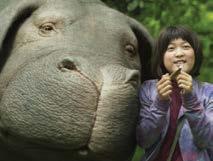
VFX Houses: Deluxe’s Method Studios, 4 Creative Party
VFX Supervisor: Erik-Jan De Boer, Jun Hy oung Kim, Jeon Hyoung Lee

Highlights: The team at Method Studios created the life-like giant pig star of the movie, which is roughly 12 feet long, eight feet tall and weighs about 12,000 lbs. Oscar-winner Erik-Jan de Boer (Life of Pi) refined the look of the creature and developed a highly detailed asset that would seamlessly integrate with practical footage. “We aimed to make Okja a realistic presence on set and focused on making the young actress playing Mija comfortable even though her primary costar is an inanimate foam shape,” says de Boer. “We had intricate shots with upwards of five people touching Okja at once, shots where Okja is in frame for a full minute, and many shots with Mija hugging Okja, allowing time to scrutinize every contact point and shadow. This required lots of roto, paint, rotomation and animation with an incredibly high fidelity.”

VFX Houses: Mr. X VFX Supervisor: Dennis Berardi Highlights: Berardi and his team worked on over 60 minutes of the film (either digital en hancement or full digital creation). “I’m most proud of the opening sequence, where we start with an underwater seabed, which was entirely digitally created by Mr. X and move up into a set piece (Eliza’s apartment), which we shot dry, using smoke and projectors. We floated furniture, some of it was practically hung on monofilament, and some were digi tally animated.” The vfx artists also did a terrific job mixing the footage of actor Doug Jones in creature costume with keyframe animation to deliver the bioluminescent glow. The cre ative team looked to nature and sea creatures that generate their own light, like cuttlefish, to come up with the memorable glow of the crea ture from the Amazon.
Star Wars: The Last Jedi Studio: Disney VFX Houses: ILM, Hybride, Important Look ing Pirates, Jellyfish, One of Us, Rodeo FX, Blind Ltd.
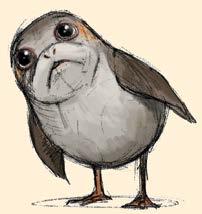
VFX Supervisors: Richard Bain, Ben Morris, Michael Mulholland, Chris Corbould Highlights: To put things into perspective, all three movies in the original Star Wars tril ogy won Oscars for their vfx achievements. The first two of the prequels were also nom inated (Revenge of the Sith was ignored). The Force Awakens and Rogue One also received Oscar noms, so the odds are pret ty strong for The Last Jedi as well. There are plenty of breath-taking visuals to celebrate in Rian John son’s deeply satisfying opus, who takes the franchise to unex pected heights, from clearly cho reographed action sequences and lightsaber fights to the puffin-inspired Porgs, the remarkable sea birds that kept Luke company on the planet Ahch-To.
Studio: STX Entertainment
VFX Houses: Weta Digital, ILM, Rodeo FX
VFX Supervisor: Scott Stokdyk
Highlights: Stokdyk, who won the vfx Oscar for his work on Spider-Man 2 12 year ago, has the challenging task of working with a huge amount of concept work from artists all over the world. Set in the 28th century, Luc Bes son’s movie is based on a popular French com ic-book series and features a host of amazing alien backdrops and creatures. Human ac tors interacted with alien characters using mo-cap suits, then a pass with only human characters was record, and all had to be put together smoothly in post. Another highlight was a shapeshifting alien named Bubble, played by Rihanna. “A lot of it was a leap of faith, knowing that Weta could replace an arm, leg or even a face if needed,” says Stokdyk. “The technology gives us free dom to make something interesting.”
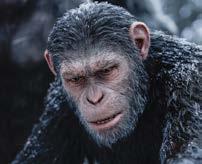
Studio: Fox
VFX House: Weta Digital
VFX Supervisors: Joe Letteri, Dan Lemmon, Erik Winquist, Dan Cervin
Highlights: This year’s acclaimed chapter of the sci-fi epic found Andy Serkis’ Caesar out on a revenge mission that takes him through extreme snow and other conditions that would have been impossible to visualize a few years ago. As Joe Let teri told Dead line, “War takes us on this epic journey into really harsh conditions, where we were capturing in the snow, and in the rain, and really difficult loca tion work … But it showed that you can take this technology and evolve it, and directors and actors can use it to create a scene any where.” The characters’ nuanced performanc es, the realistic interaction of digital fur with snow, a beautiful sequence featuring Apes rid ing horses, and some stunning close-up work (made possible by Weta’s Manuka renderer) are among the film’s many vfx highlights. ◆
Image credits: Alien head “Odd Studios/ Creatures Inc.”; Kong head “Digital maquette by ILM”; Shape of Water “In-progress shot”
In the past, animated features have often been shut out when it comes to below-the-line awards, but the tide may be turning.
By Karen IdelsonAnimated features have never just been for kids. They bring millions of people to movie theaters worldwide each year. They’re some of the most consistent per formers at the box office, home entertainment kiosks, packaged media sales and in down loads. Many of the world’s most talented and lauded filmmakers tell their stories through animation. However — outside of the animat ed feature, short film and song categories at the Academy Awards — you’d struggle to re member the last time someone was nominated outside of those categories for the work they’d done on an animated film.
Even though they’re not racking up Acad emy and other awards season nods, the cos tume designers, sound designers, cinematog raphers and many other members of the crew who work in animation face the same challeng es, solve the same problems and essentially do the same kind of work as they undertake a live-action project.
Deborah Cook, a highly regarded costume designer and puppet modeler, made all of the costumes for LAIKA’s 2014 stop-motion film The Boxtrolls by hand because there isn’t a
costume rental house for miniature costumes and there’s really no place to buy them, either. So, she must design costumes, select fabrics and often hand dye them to create the right colors. Cook is on the forefront of costume work in animation. Last year, she became the first designer to receive a nomination from the Costume Designers Guild for her work on Kubo and the Two Strings
“I see our talented team of filmmakers as equal to live-action filmmakers. We have the same expertise and, additionally, have a spe cialist knowledge of stop-frame filmmaking and a skill set for smaller-scaled details,” says Cook. “I feel proud that my nomination chal lenged the wider movie industry to see us as equals and competitors in any comparable category in the industry.”
Costume designers for animation also sometimes design costumes that aren’t actu ally built in the traditional way (they’re creat ed using software and then wrapped around a character). Other times, a costume that has
already been created by hand is then scanned and the dimensions are taken into the com puter for an animated character. Jacqueline Durran’s work for the Beast’s wardrobe in this year’s live-action Beauty and Beast went through just that adaptation.
These kinds of technological changes have made costume design for animation difficult to describe and, as a result, difficult to nominate or award, according to Salvador Perez, presi dent of the Costume Designers Guild.

“In the past, costume designers who worked in animation were sometimes called ‘character designers,’ so it wasn’t something that was necessarily recognized,” says Perez. “You have to keep up with the technology and once the amazing work of Deborah Cook was submitted as costume design, it was noticed, because how could you not see how much work she put into Kubo?”
Perez says the Costume Designers Guild is also working on outreach programs that edu cate its members in the technological changes coming to their industry as costume design is increasingly done for both live actors and ani mated characters, whether they’re in “live-ac
tion” films or purely animated features. The Academy itself once included anima tors under the Short Films branch of AMPAS. It wasn’t until 1995 that it became the Short Films and Animation Branch in order to better suit animators who often worked exclusively in feature animation.
In the past, hybrid films like Who Framed Roger Rabbit and Mary Poppins have also re ceived nods and awards. The former won for best visual effects, best film editing and best sound effects editing. In 1964, Mary Poppins won for best actress, best visual effects, best film editing, best original song and best score. Perhaps the Academy Awards catego ry that’s seen the greatest influx of animated nominees is sound editing, which involves cre ating and designing the sounds we hear in films. In the last 20 years, Monsters, Inc., Finding Nemo, The Polar Express,
Winning Threads: Last year, Deborah Cook became the first animation artist to receive a nomination from the Costume Designers Guild for her work on Kubo and the Two Strings

Ratatouille, WALL’E, Up and Toy Story 3 have all been given nods for sound editing. Sound designer Randy Thom won this category alongside Michael Silvers for their 2005 work on The Incredibles
“Animated films are too often disrespected in general and not taken seriously as storytell ing, partly because they tend to be aimed at children — which is odd, because we all know that some of the greatest novels and stories in history have been aimed at children,” says Thom. “I think that another problem is that a lot of Oscar voters just don’t see animated films.”
Thom believes that the Oscar voting con tingent tends to be older than your usual ani mation audience. However, he sees that trend changing, which is a good thing. “People who have children under 12 are a little more likely
to be exposed to animated films because their kids want to see them over and over again at home,” he points out. “But it’s not something that’s on the consciousness of Oscar voters when it’s time to nominate films. And animated films often don’t involve shooting on a set … and that is the image that all of us – even the people on the inside of the entertainment in dustry – have of filmmaking. So, in some weird way, we don’t think of animated films as films. They’re something else.”
This year, Thom worked on both Fox/Blue Sky’s Ferdinand and Universal/Illumination’s Despicable Me 3, which means he handled sound for invented minions, a variety of farm animals and animated humans. Thom also worked on The Revenant, and believes the challenges of great sound design are the same from project to project.
“In terms of sound specifically, I think great sound is too often taken to mean lots of sound, and far too often it’s taken to mean lots of gunshots and fighting,” says Thom. “A very high
‘In the past costume designers who worked in animation were sometimes called character designers so it wasn’t something that was necessarily recognized.’
— Salvador Perez, president of the Costume Designers Guild
percentage of films that get nominated for sound Oscars are films with lots of bat tle scenes. We think loud sound, lots of sounds, that must be good sound. And, to be honest, I think one of the reasons The Incredibles won an Oscar is that it’s an action film.”


Thom also points out that a large num ber of the sound pros in the Sound Branch of the Academy — which generates the nominations for the sound categories — work on physical mov ie sets instead of ani mation. So, they may not have as strong a connection to sound work done for animated features.

Thom, Cook and Perez would all like to see
greater education made available for their guilds and Academy voters overall so that the work done for animated films is better
understood. As the membership of the Academy grows and changes to include more filmmakers working in animation, there may be deeper understanding of ani mated filmmaking.
“We’re stepping up to educate voters in our expertise. See LAIKA’s widely doc umented first exhibi tion currently open until May 2018 at The Portland Art Museum in Oregon that cov ers our first four films,” offers Cook. “I’d love more focus given to our artistry for the vot ers to get a clearer un derstanding of our hy brid film and for them to see just how tactile and beautifully detailed our characters and environments are and how they’re inimitable.”
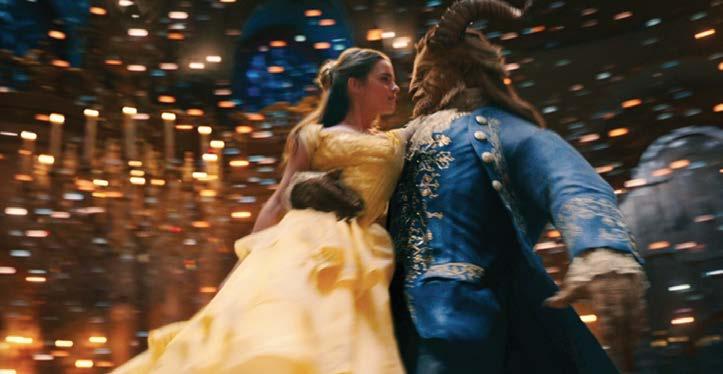
‘We think loud sound, lots of sounds — that must be good sound. And, to be honest, I think one of the reasons The Incredibles won an Oscar is that it’s an action film.’
— Oscar-winning sound designer Randy Thom
In case you are keeping tabs, here is the list of the past year’s top 10 animated
vfx-driven movies
the U.S. box office.
Rank, Title (Studio)
Despicable Me 3 (Universal)
The LEGO Batman Movie (Warner Bros.)
The Boss Baby (DreamWorks)
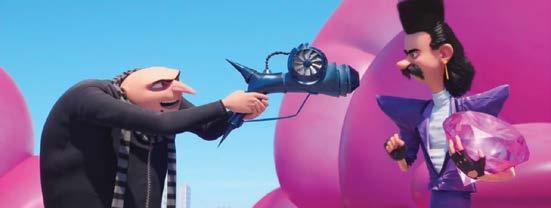
Coco (Disney-Pixar)

Domestic Gross
$264,624,300
$182,061,459
$175,750,384
$175,003,033
Cars 3 (Disney-Pixar) $152,901,115
The Emoji Movie (Sony)
Captain Underpants (DreamWorks)
The LEGO Ninjago Movie (Warner Bros.)
$86,089,513
$73,921,000
$59,281,555
Smurfs: The Lost Village (Sony) $56,760,105
The Nut Job 2: Nutty by Nature (ToonBox/Red Rover) $45,020,282
Rank, Title (Studio)
Star Wars: The Last Jedi (Disney)
Domestic Gross
$533,089,228
Beauty and the Beast (Disney) $504,014,165
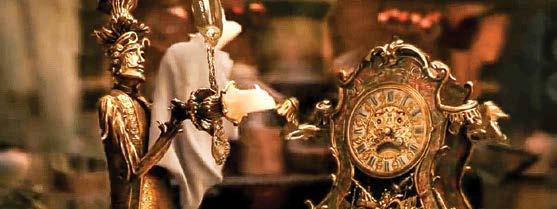
Wonder Woman (Warner Bros.)
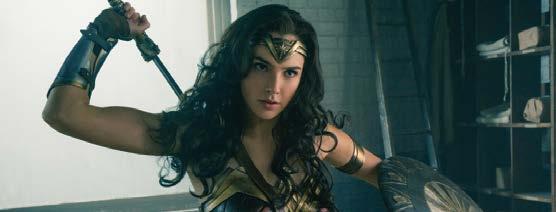
$412,563,408
Guardians of the Galaxy 2 (Disney) $389,813,101
Spider-Man: Homecoming (Sony) $334,201,140
It (Warner Bros.) $327,481,748
Thor: Ragnarok (Disney)
Logan (Fox)
Justice League (Warner Bros.)
The Fate of the Furious (Universal)
$311,441,239
$226,277,068
$225,897,455
The Annie Awards will celebrate another year of brilliant achievements in animation and visual effects by indie artists and studio teams alike.


One of the best things about working in the animation and vfx industry is attending the International Animated Film Association’s (ASIFA-Hollywood) Annie Awards every year. This year’s event, which takes place on Saturday, Feb. 3 at UCLA’s Royce Hall, promises to be another unfor gettable celebration of the art and amazing people who work in the industry. We caught up with AS IFA-Hollywood President Jerry Beck to get his take on the 45th edition of the awards, which features 36 categories as well as special juried awards.
“We are still in the planning stages, but we have a new stage set and we’ll unveil a new logo,” says the distinguished animation historian and author. “What’s different and exciting is — as always — the range and scope of the nominees. The energy of the event comes from our members and the quality of the features and TV represented. The range of techniques being honored include retro-style video games (Cuphead is getting a special award) to oil painting animation, from major studio CGI to anime,
and some incredible virtual reality innovations.”
Beck says audiences should expect a few jaw-dropping surprises, but he promises that nobody will read the wrong winner for Best Picture! He adds, “A highlight for me — and I’m so proud of our nominee judging committees, all made up of industry peers in each category — is the quality of the nominated films and filmmakers. The Annie Awards is truly a celebra tion of all the incredible talent in the field today. It’s a huge turn-around from the way the business was when I moved to Los Angeles in 1986, when ani mation was defined by low-budget Saturday morn ing cartoons, a few feature films, commercials and scattered independent shorts. Today, we have over 20 features per year, loads of gaming, opportunities in special effects, programming on cable TV, stream ing channels, on and on. And, almost every college has a serious animation program. The Annies truly reflect the best of our community over the last year. You want to see the future of animation? Keep your eyes on our nominees and winners.”

Overall, Beck believes the animation and vfx in dustry couldn’t be healthier.
“We are still a stepchild to the movie industry, but those of us in the field, those of us who make films, those of us who devote ourselves to animation know it is the greatest expression of art and storytelling in cin ema,” he stresses. “There are more voices making new features, shorts and series. More voices, more choices, more ideas, more inclusion. It’s not just Hollywood — it is truly an international medium without boundaries.”
This feeling of bright optimism also includes what is in store for us in 2018. “I’ve only seen snippets of some of the upcoming features slated for next year and — to be honest — it looks like we will top ourselves again in 2018. The whole field is moving forward and I’m happy to say: that’s how it should be!” ◆
To learn more about this special cele bration and to nab your tickets before they’re gone, visit www.annieawards.org.

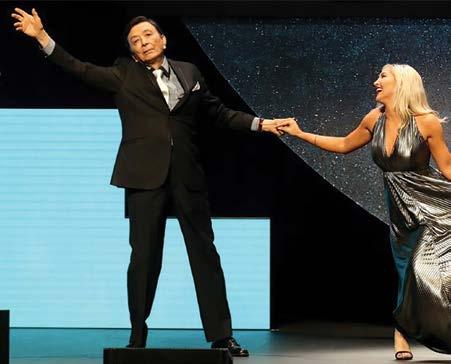
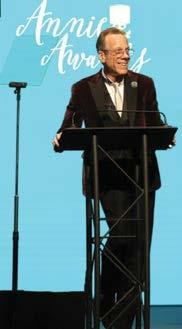
Here are some of the 45th Annie Awards nominees in the major categories:
Captain Underpants (DreamWorks)
Cars 3 (Pixar)
Coco (Pixar)

Despicable Me 3 (Illumination)

The Boss Baby (DreamWorks)
Best Animated Feature (Independent)
In This Corner of the World (Taro Maki, GENCO, Masao Maruyama, Mappa Co.)

Loving Vincent (BreakThru Films)

Napping Princess (Nippon TV)

The Big Bad Fox & Other Tales (Folivari, Panique!, Studiocanal)
The Breadwinner (Cartoon Saloon, Aircraft Pictures, Melusine Prod.)

Imaginary Friend Society “Feeling Sad” (Hornet)
Olaf’s Frozen Adventure (Walt Disney Animation Studios)
Pig: The Dam Keeper Poems (Tonko House, Inc.)
Revolting Rhymes (Magic Light Pictures)
Tangled: Before Ever After (Walt Disney Television Animation)
Best Animated Short Subject
Dear Basketball (Glen Keane Prod., Kobe Studios, Believe Ent. Group)
Hedgehog’s Home (National Film Board of Canada, Bonobostudio) Negative Space (IKKI Films, Manuel Cam Studio) Scavengers (Titmouse, Inc., Adult Swim)
Son of Jaguar (Google Spotlight Stories, Reel FX)
Best Animated TV/Broadcast: Preschool
Mickey and the Roadster Racers “Goofy Gas!” (Disney TV Animation) Octonauts “Operation Deep Freeze” (Vampire Squid, Silvergate Media, Brown Bag Films)
Peg + Cat “The Mariachi Problem” (The Fred Rogers Co., 100 Chickens Prod.)
The Stinky & Dirty Show “HaHaHigher / The Waiting Game” (Amazon Studios)
Through the Woods “A Snowy Morning” (Houghton Mifflin Harcourt, The Fred Rogers Co., PIP Animation Services)
Buddy Thunderstruck “To Protect and Swerve / Robo Truck of the Future” (Stoopid Buddy Stoodios, American Greetings for Netflix) Lost in Oz “The Pearl of Pingaree” (Amazon Studios) Niko and the Sword of Light “From the Cliffs of Catastrophe to the Pools of Destiny” (Amazon Studios)
Tangled: The Series “Queen for a Day” (Disney TV Animation) We Bare Bears “Panda’s Art” (Cartoon Network)
Best General Audience Animated TV/Broadcast
Big Mouth “Am I Gay?” (Netflix)
BoJack Horseman “Stupid Piece of Sh*t” (Tornante Prod. for Netflix) Rick and Morty “Pickle Rick” (Williams Street Prod.)
Robot Chicken “Freshly Baked: The Robot Chicken Santa Claus Pot Cookie Freakout Special: Special Edition” (Stoopid Buddy Stoodios) Samurai Jack “Episode XCIII” (Adult Swim)
Cradle (Devon Manney) Elsewhere (Junyi Xiao)
Good Night, Everybuds! (Benedikt Hummel) Once a Hero (Xia Li) Poles Apart (Paloma Baeza)
Winsor McCay Awards for career contributions to the art of animation: British character animator James Baxter; SpongeBob SquarePants creator Stephen Hillenburg; Oscar-winning Canadian directors Wendy Tilby & Amanda Forbis (When the Day Breaks, Wild Life)
The Ub Iwerks Award for technical advancement: TVPaint, for its versatile software for 2D animation
The Special Achievement Award: Studio MDHR Entertainment for its 1930s-inspired wonder-game Cuphead.
The June Foray Award: Animation historian Didier Ghez. The Certificate of Merit will be awarded to David Nimitz, devoted friend and caretaker of veteran voice actress, and ASIFA-Hollywood & Annie Awards pioneer, the late June Foray. ◆

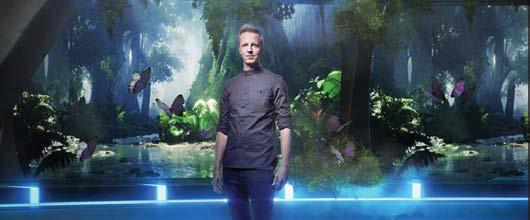 By Stig Olav Kasin Chief Content Officer, The Future Group
By Stig Olav Kasin Chief Content Officer, The Future Group

TV is in need of reinventing itself as stream ing and on demand services are prolifer ating, eSports is on the rise, and gaming is becoming increasingly mainstream. At The Future Group, we want to merge real and virtual worlds, and create shows where TV contestants and viewers at home are put into the same virtual universe, competing in the same challenges and winning the same prizes.
To make this happen we use our own propri etary technology Frontier™; a heavily-enhanced version of Epic’s Unreal game engine and Ross Video hardware. Frontier lets us merge the physi cal studio environment with vir tual worlds, allowing TV contes tants in the studio to compete in the same virtual worlds as view ers at home, who can access the same games through their mobile devices. We call this In teractive Mixed Reality™.
Lost in Time is the world’s first Interactive Mixed Reality game show, made in col laboration with FremantleMedia (Idols, X-Factor) It was launched on Discovery Network’s TVNorge channel in Norway during spring this year. Now, two seasons of 13 episodes each has been com missioned by Dubai Media Group’s Dubai TV for airing in 22 territories in 2018. In each episode of Lost in Time, three contestants work together to increase the prize pot before they go head-tohead in a winner-take-all final, while a lucky player at home wins the same cash prize. For TV contestants, the action takes place in a green-screen studio, where all physical props and cameras are connected to Frontier. While the contestants are driving, shooting, solving
logic puzzles and overcoming obstacle courses in the studio, graphics are rendered in real time to show the contestants inside the virtual worlds. This way, one studio can transport contestants to the Ice Age, Space Age or Medieval Era with a minimum of physical props. All physical props are connected directly to triggers inside the game engine, so actions done in the real world influence the outcome in the virtual world.
The games are created to be just as fun and chal lenging for contestants in the studio as they are for someone sitting at home playing on their mobile or tablet. Since everything is made with the same game
precedented average of 28 percent interactivity. Throughout the whole season, the average play ing time in the app was more than 19 minutes per session. This shows great engagement of viewers during the broadcast and throughout the week. Being able to extend how people interact with a show is good news for broadcasters who increasingly face competition from online com petitors. Although Lost in Time was initially made for linear television, the underlying technology can just as easily be used to create shows for stream ing platforms like YouTube and Twitch—creating a true interactive experience for everyone involved.
engine, we receive data on how studio contestants and players at home fare, making it possible to pit the two against each other. This creates unique possibilities for TV and game producers alike.
One key benefit for broadcasters is data acquired from users. Far from being a simple second-screen app, Lost in Time is part of a so cial entertainment platform that can be played throughout the week. This is different to previous attempts at second-screen experiences where the app functionality is but an add-on to an exist ing TV show. The more you play and engage with the Lost in Time app, the higher your chances are of winning the big prizes when the show is on TV.
During broadcasts, Lost in Time had an un
Advertisers can be part of the games on the app, and are no lon ger confined to a single TV slot. This lets them tailor-make games and puzzles that tie directly into the game play, becoming a seamless part of the experience. For game producers it opens up the possibil ity that the big screen is not solely meant as consumption of content, but an integral part of the game itself. Games can be produced with TV in mind. Down the road we might even see games experienced as a coherent whole across VR, AR, TV and mobile devices simultaneously. Actions commit ted by a player at home can influence what happens in the studio live. Although this next level of crossplatform gaming is a few years into the future, the first steps towards a future of Interactive Mixed Reality entertainment is definitely taken with Lost in Time ◆
Stig Olav Kasin is the Chief Content Officer of the Norway-based The Future Group. You can learn more about the company at www.futureuniverse.com.
‘As game engines and interactive entertainment formats turn TV viewers into users, they offer groundbreaking opportunities for broadcasters, game producers and advertisers.’Fridtjof Nilsen hosts the Norwegian version of Lost in Time New Frontier: Fremantle Media and Future Group’s game show Lost in Time follows three contestants as they are transported into different eras.









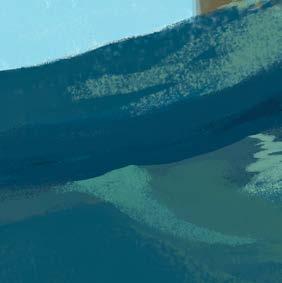
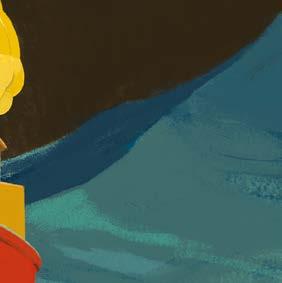
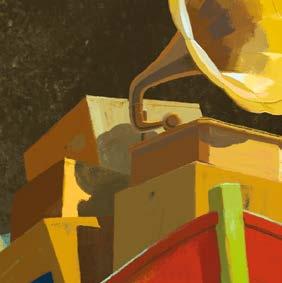




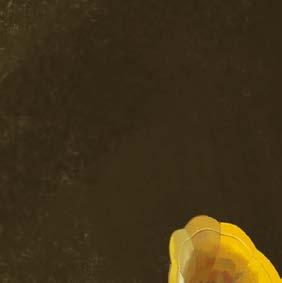
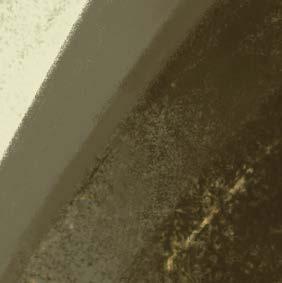
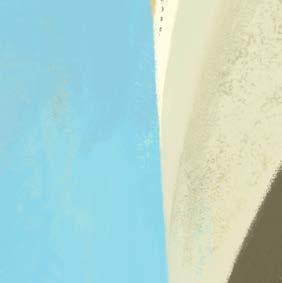

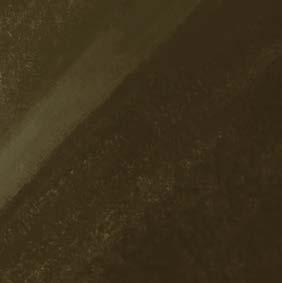







Hot Streets, Adult Swim’s crazy, off-center new toon, is everything we need this winter.

 By Ramin Zahed
By Ramin Zahed
If you like your animated shows edgy, un conventional and packed with surreal hu mor, the folks at Adult Swim think you are likely to flip for their latest offering, Hot Streets. Created by Brian Wysol, a veteran writer for Robot Chicken, Future-Worm and Rick and Morty, the 2D-animated show centers on the wild adventures of FBI agent Mark Branski, his partner, his niece and her dog as they look into strange paranormal happenings. Seth Green, Matt Senreich, John Harvatine IV, Eric Towner, Justin Roiland and Wysol are exec producing the much-anticipated toon.
Prior to the series, Wysol had made a series of shorts for Dan Harmon and Rob Schrab’s Channel 101 outfit, in cluding Hot Cross Buns and We Solve the Crime.
“One was a supernatural horror cartoon and the other was a cop show, and they were my favor ites,” says Wysol. “I want ed to weave their sensi bilities together, so I came up with the idea for this new FBI supernatural investigative show.”
Senreich, who along with Green, Harvatine and Towner is one of the founders of Burbank’s Stoopid Buddy Stoodios (Robot Chicken, Su perMansion), was first introduced to Wysol by Rick and Morty co-creator Roiland. “We brought him on board Robot Chicken, and we really wanted to get him in front of Mark Lazzo

[Adult Swim exec VP],” note Senreich. “We then made the pilot at Stoopid Buddy, and it’s been a blast since then.”
Wysol’s wild creativity is one of huge rea sons that the show stands out from similar animated fare, says Senreich. “He does a lot of the animation, even the music … he would work on one sequence, then he’d go back and fix it. Brian has a different kind of sensibility than the rest of us: He’s a real renaissance man. The show is the perfect combination of Rick and Morty and Robot Chicken in a way. It has the fast-paced jokes of Robot Chicken with the character definition of R&M. You think you know where the show is going in the first
one of Wysol’s biggest challenges. “I had to make some important decisions, and I kind of learned the job by being thrown into this posi tion. I was lucky to have Matt and Justin and all the Stoopid Buddy guys guiding me along the way. Midway through, I kind of knew what I was doing. I am quite pleased with the pro gression of the show. I love the first couple of episodes, but I think we really found our voice by the third voice. Also, the season ender is quite unusual. I think when you get to the fi nale, you will want to go back and revisit the earlier episodes!”
— Creator Brian Wysol10 seconds, but then it jumps to other things and takes you to a completely different place!”
The series’ animation, created by the team at Stoopid Buddy Stoodios in Burbank (about 25 to 30 staffers) and Salty Dog Pictures in Ire land, is produced using Toon Boom Harmony. The first season, which premieres this month, will offer 11 quarter-hour episodes in total.
Being a showrunner for the first time was
For Senreich, the four central characters of Hot Streets are unlike anything else he has seen before. “I am quite proud of these very dif ferent main characters. They may seem like silly characters at first, but once you get to know them, you discover that there’s something quite heartfelt about them. While each episode is a stand-alone, we get to see them grow and have their own character arcs.”
Also high on the creative team’s priorities was not sacrificing the adventure quotient for simple jokes. “I really wanted it to be an adventure show as well,” explains Wysol. “We
‘Don’t be afraid to create your own content. Even if it’s not good at first, you should keep going, make something else and strive to get better.’Oddballs on the Case: Hot Streets follows the off-the-wall adventures of an FBI team investigating odd paranormal phenomenon.
skipped elements of the sitcom in order to have adventure-packed, plot-heavy outlines. Our outlines were 11 to 15 pages long and our scripts for each show were about 20 pag es long. We didn’t cut any jokes, so it has this frantic pace. It’s dense, but it has everything in it. Although it moves very fast, it is still mostly about the characters.”
Since Wysol was used to applying his personal style to his original web cartoons, he says he had to make some adjust ments to the world of TV animation. “I was used to doing these old car toons which had one or two characters, but now I have this amazing crew and directors, and we have all these characters to play with. The challenge was adapting the style from my hand-drawn web shorts to a TV animated proj ect. It took a lot of retakes, lots of moments when characters go off-model and look more detailed. We do change the visual style at times to adjust for the jokes.”
Both Wysol and Senreich are quite excited about the state of TV animation these days.
“There are so many cool shows out there,” says Wysol. “There are some great series on Adult Swim and Cartoon Network. I also love anime, and we’re seeing so many amazing things coming from Japan. There are shows like BoJack Horseman that is doing something
when I first started to make cartoons. It’s also important to find like-minded people to work with. It’s always great to be inspired by other shows. Don’t be afraid to create your own con tent. Even if it’s not good at first, you should keep going, make something else and strive to get better.”
very different. I think we’re in a very interesting place right now.”
As Senreich chimes in, “We have so many more places to watch animation, and the stuff we can watch is so engaging. I watch a lot of an imation, and I’m a 43-year-old man. I’m not afraid to say it today, but there was a time, years ago, when you couldn’t really admit that in public.”
Wysol is also happy to offer some helpful advice to animation business hopefuls. “Make stuff even if you’re bad,” he says. “I was bad
Senreich, who has won two Emmy Awards (plus nine nominations) and has been an integral part of Robot Chicken for the past 12 years, agrees. The veteran writer/producer says the most important thing you can do with your ideas is to make things. “I didn’t know how to do it at first. I wasn’t professionally trained to be an ani mation writer, but I was lucky to know amazing people who taught me how to do it. Stay fo cused and find people who are better than you to teach you the ropes. Then apply what you’ve learned and adapt your own style.”

◆
Hot Streets premieres Sunday, January 14 at midnight on Cartoon Network’s Adult Swim.

‘You think you know where the show is going in the first 10 seconds, but then it jumps to other things and takes you to a completely different place!’
— Exec producer Matt SenreichMove over, Scooby-Doo: Justin Roiland voices the show’s most memorable character, Chubbie Webbers, a talking dog who solves crimes and hangs out with colorful aliens.
Producers Lynn Wang and Ed Skudder share the secrets of Warner Bros. Animation’s brightly colored Unikitty!
 By Ramin Zahed
By Ramin Zahed
There’s a whole lot of pink sparkle com ing to Cartoon Network’s Friday lineup this month. That’s because Warner Bros. Animation is delivering the awesome new show Unikitty! to the cabler. The much-antic ipated spin-off of Phil Lord and Chris Miller’s acclaimed 2014 pic The LEGO Movie follows the adventures of the spirited ruler of Uniking dom, her little brother Prince Puppycorn, resi dent scientist Dr. Fox and the loyal bodyguard Hawkodile.
Featuring the voices of Tara Strong, Grey Griffin, Kate Micucci, Roger Craig Smith and Eric Bauza, it’s the kind of toon that digs its claws in you and gets you hooked on its bright colors and fast-paced humor. As producers Lynn Wang (Star vs. the Forces of Evil) and Ed Skudder (Pickle and Peanut) tell us, the whole enterprise began a couple of years ago, when Warner Bros. decided to tap supervis
ing producer Aaron Horvath (Teen Titans Go!, MAD) to flesh out the world, style and other characters that appear in the show. The show got the greenlight to start production at the end of the summer of 2016.

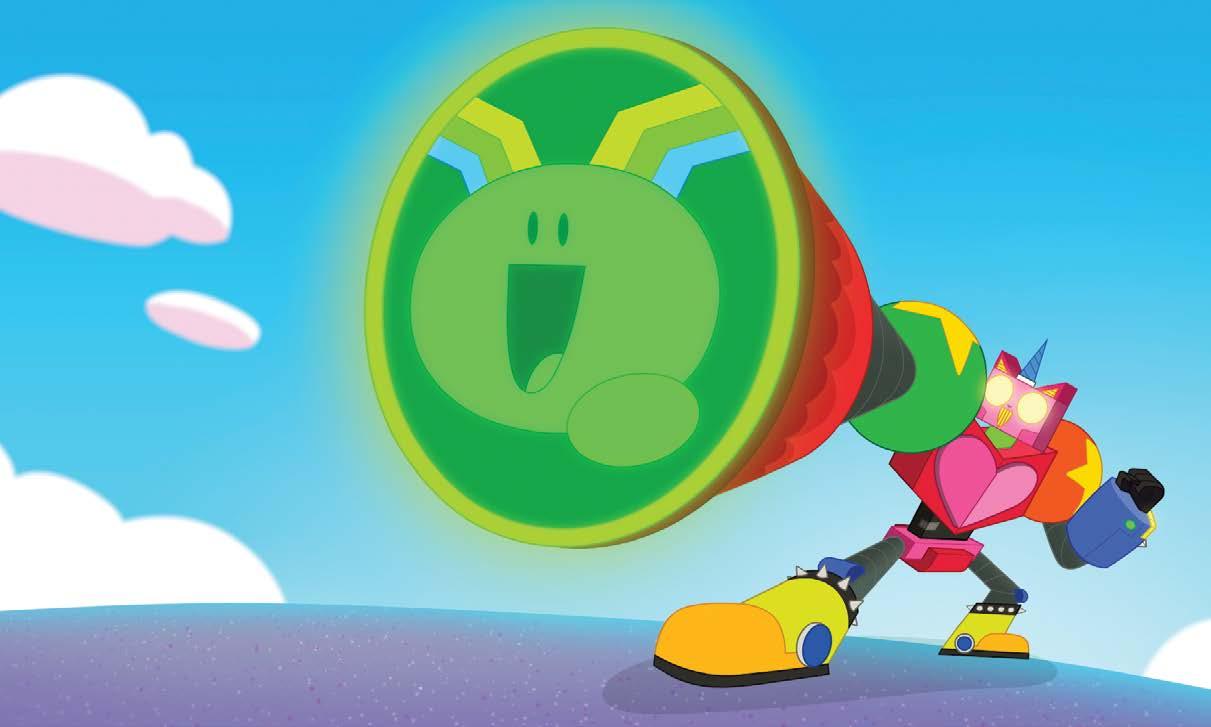
The producers point out that the cre ative team spends a lot of time and effort to make Unikitty! look as polished as possible.
“A ton of love goes into every frame, and we think it adds so much to the viewing experi ence,” notes Skudder. “Our art director, An drea Fernandez, really worked hard to create a world where it feels like you could reach out and touch it,” adds Wang, “From a story per spective, while there’s a lot of monster punch ing and explosions, we always try to give the show a positive message at its core. Unikitty is known for saying, ‘Stay positive!’ So we love that the show stays positive, too.”
Both Skudder and Wang mention shows
such as The Amazing World of Gumball, Lord and Miller’s Clone High and FLCL as their points of influence. “We both grew up watch ing both American Saturday morning cartoons and anime, so the show has a healthy dose of both influences. We want it to feel as goofy as SpongeBob and as intense as a blockbust er movie,” they offer.
Of course, playing around with a dynamic character like Unikitty offers its own share of rewards. “Unikitty’s an awesome charac ter to play around with, because one sec ond she can be a ridiculously sweet magic princess, and then a second later be a death-metal-fueled fire tornado, so we’re never bored with her character,” says Wang. “She’s such an energetic and almost stubbornly optimistic character that we’re constantly find ing new ways to have fun with her. The whole cast of characters (Puppycorn, Dr. Fox, Hawko
dile, Rick, and the baddies Master Frown and Brock) have very distinct personalities of their own, so it makes it really fun to watch them match up against Unikitty’s character.”
Skudder says he especially likes the Toaster and Toast characters. “They started as a oneoff gag and have turned into total staples of the show,” he explains. “They’re in tons of epi sodes and almost always just yell, ‘OOHHH!!!’ I also really like Hype Bot. He’s so annoying — and sooo cool!” Wang says her favorite in cidental is a character called FeeBee. “She’s a mix between a bee and a flower — and she’s possibly crazier than Unikitty!”
Lots of Kitty to Go Around Unikitty! fans will be happy to know that the first order of the show is for 80 11-minute episodes.The show’s pre- and post-production work is done in Burbank by Warner Bros. Ani mation. “We’re mostly a script-driven show, and we work with our directors, storyboard artists and editors to punch up jokes, story points and dialogue, whatever it may need as we see the episode evolve,” note the producers.

“The final animatic and all our designs are sent overseas to the Philippines, where the very talented team at Snipple Animation Studios provide our animation. Our amazing in-house animation crew, led by Anna Holling sworth, does additional design, animation and compositing work to finish each episode off.”
Skudder and Wang are quick to mention the importance of their favorite animated films and TV shows on their personal style and artistic growth. “I grew up loving Bruce Timm’s Bat man: The Animated Series,” says Skudder. “I watched it every single day after school and it really inspired me to pursue art and story
telling. And even though he’s not an animator, Bill Watterson was a huge inspiration to me — Calvin & Hobbes was (and is) my favorite comic, and the art style was so animated and had so much movement baked into the panels. I always wanted to make things move the way that comic looked.”
Wang cites classic Disney animators, Hayao Miyazaki and Jamie Hewlett as some of her biggest influences. “I also adored shows like Sailor Moon, Digimon and the Doraemon shows and comics,” she recalls. “And like most girls in the ’90s, I was obsessed with anything Lisa Frank!”
The producers have been quite pleased with the early positive reactions to the show. “We’ve tried to make each character really unique, but also really genuine,” says Wang. “Unikitty has flaws, but she embraces them, and even makes the most of them. There’s something for everyone to relate to some where in the show, and we think at the end of the day people gravitate towards the positive.
lot to wrangle past the finish line. But it would be a lot tougher if it weren’t for our crew. We feel constantly lucky to be working with some of the most talented, hardworking, inventive and genuinely awesome people in the industry.”
Unikitty and her friends love each other more than anything in the world, and we think that can be a really fun and honest experience for audiences.”
Of course, the show has its share of challeng es as well. “Unikitty is such a big character, who lives in a big world with a big cast,” says Skud der. “On top of that, we’re producing a huge amount of content and doing our best to help our team make it as good as possible, so it’s a
Looking at the crazy, super-busy world of an imation in 2018, Wang and Skudder are quite optimistic about what lays ahead. “There’s so much content being generated for so many platforms, both domestically and internation ally, so there’s no shortage of work,” they tell us. “But at the same time entertainment’s ob viously going through enormous changes and still has such a nebulous future. It’ll be inter esting to see how the world adjusts to more and more digital content and streaming-based media consumption. Everyone is being forced to kind of reinvent the wheel and think differ ently, but we think ultimately it’s providing an energetic breath of fresh air to content and is opening a lot of new doors for formats and ideas that weren’t possible before.” Unikitty!’s sharp producers are also happy to share some of their hardearned wisdom with anima tion hopefuls. “The most important two things are to hone your skills and connect with the industry and your peers,” they suggest. “Hav ing a body of quality work to show and a network of con tacts to show it to is one of the strongest ways to get a foot in the door. Also, keep in mind that it can take a long time. Success rarely happens on the first try, so always remember to be pa tient and persistent.” Now that is some solid advice that even Unikitty and her wacky friends would be smart to
Unikitty! airs Fridays at 6:30 p.m. on Car toon Network.
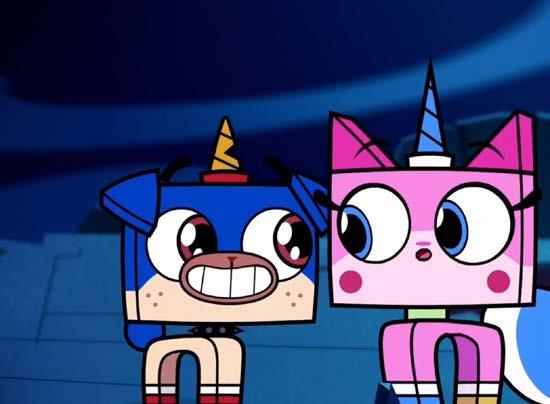
‘From a story perspective, while there’s a lot of monster punching and explosions, we always try to give the show a positive message at its core.’
— Producers Lynn Wang and Ed SkudderFiercely Optimistic: Voiced by Tara Strong, Unikitty is the cheerful ruler of a colorful world who is very protective of her brother Puppycorn, resident scientist Dr. Fox, her bodyguard Hawkodile and Richard, a 1x3 grey LEGO brick! By Martin Grebing
Ever wonder if you really are best suited as a full-time employee or if your true calling is to venture out on your own? Answer the following questions as Strongly Agree (SA), Neutral (N), or Strongly Disagree (SD), tally your score with the Scoring Key, and see where you stand. The answer might surprise you!
1. I like focusing on only one aspect of a project.
2. I love having set work hours every day.
3. I like to take risks.
4. I like being given a list of tasks to accom plish.
5. I like creating task lists.
6. I do not enjoy delegating tasks.
7. I like being involved in one project at a time.
8. I am comfortable with public speaking.
9. People gravitate toward me.
10. I am a team player.
11. I like receiving a steady paycheck.
12. I like having a flexible schedule.
13. I have vast knowledge of my industry.
14. I’m constantly seeking advancement.
15. I would like to be promoted but I’m happy where I am.
16. I deserve to be promoted more than any of my contemporaries.
17. I am an excellent communicator.

18. I finish all of my tasks, no matter what.
19. I’m constantly looking for patterns.
20. I enjoy carefully following each step in an already established process.
21. I like to come up with my own processes.
22. I don’t take very many notes.
23. The unknown excites me.
24. I am good at troubleshooting problems.
25. I try to troubleshoot things in advance before a problem presents itself.
26. I always try to make things better.
27. I always want more.
28. I am mainly technical.
29. I am mainly creative.
30. I see things in black and white.
31. I see things differently than most people.
32. I’m not very good at reading people.
33. I like to collaborate.
34. I like to work on my own.
35. I like to view an idea from many different perspectives.
36. I feel the need to control everything I can.
37. I tend to be a conventional thinker.
38. I am extremely curious.
39. I often get absorbed in projects and lose track of time.
40. I am relentless.
41. I enjoy a microcosmic view of things.
42. I am courageous.
43. I work on things until they are perfect, even if it takes all night.
44. I am highly reflective and like to review the day and my own thoughts.
45. I do not like to teach others.
46. I like to learn.
47. I am an optimist.
48. I have a tireless work ethic.
49. I am a team player.
50. I enjoy seeing the big picture.
climb the ladder.
50 to 35: You are a valuable employee! You are doing a great job fulfilling your role as an employee and are right where you should be, which is providing a valuable service to your company.
45 to 15: You are a great employee with potential for advancement and leadership.
15 to -19: You are very well suited to lead others in your full-time employee environment and have a good chance at continuing to
Should you choose to venture out on your own, whether as an independent pro fessional or the founder of a full-fledged animation studio, you must ooze entrepre neur and innovator traits from all your pores. The very same traits, mindset and determination that will make you a suc cessful business owner are the same ones that are needed to make you a successful in dependent professional.
On the other hand, if you are perfectly con tent (if not thrilled) to remain an employee for the remainder of your career, you should still
-20 to -45: You excel at your job and have upper management/exec utive potential. One day you may feel the need to break out on your own, but for now you would be best suited continuing to grow as an employee and learning more about the big picture of your company. -46 to -50: You have an entrepreneur and innovator spirit! You should professionally and graciously tender your resignation and start your own business now!

Disclaimer: This article is meant for entertainment purposes only. Do not quit your job (unless you re ally want to), or remain as an employee (unless you really like it there) because of the re sults of this quiz!
make strides in the entrepreneur and innovator direction as this will help get the attention of your supervisors and make you much more likely to be in the running for promotions and raises. Plus, you will contribute more to your company, which is good for everyone.
Martin Grebing is president of Funny bone Animation and can be reached via www.funnyboneani mation.com.

Afew months ago, Adobe intro duced a number of updates to its powerful tools in the Cre ative Cloud, including updates for Pho toshop, After Effects and Premiere. But, the company also released some brand new applications, or at the very least, new spins on applications.

Adobe XD CC is a tool for pro totyping UX/UI design for different devices, providing a framework to prototype, design and share your de signs not only with the stakeholders in your product, but also within the artists on the design team. Templates, styles and assets can be shared with the artist to maintain a consistent look and feel. Once a design is out, you can get im mediate feedback from users so that the next iteration hones in on the specif ic needs of your user base.
This round is 1.0 of XD CC, and is the design foundation of the tool. Mov ing forward, Adobe wants to make XD CC the place you go to for all your UX/ UI design needs. The next app on the roster extends Photoshop and Illustrator into 3D. Di mension CC (tested under the name Project Felix) is geared toward the designers and art ists out there. This is aimed at those who are interested in bringing 3D into the wheelhouse, but may not need or want the overhead and devotion to learn a full-functional 3D software like Cinema 4D, Maya, or 3ds Max.
You can choose to import 3D models you’ve made or from the Adobe Stock store, along with materials and textures, which can be ap plied by familiar drag ’n’ drop methods. Light ing can use panoramic HDRs or source lights, and the results look pretty impressive. More over, these renders can go right into Photo shop as a PSD with appropriate control mattes and passes for further refinement or integra tion into your artwork.
This is amazing for brand specialists who need to envision their designs on tons of prod ucts — cups, handbags, napkins, pens. Now the artists can place their designs onto actual
by Todd Sheridan Perryeye direction, and the ability to read and apply eyebrow movement with slants to accentuate angry or sur prised looks.

All of this is delivered with the intent of making animation fast to do, but also robust enough that one has the control to create sophisticated animation.
I should also mention that the clas sic Lightroom CC is probably known by almost all photographers out there. The new CC version essentially push es your photos out into a cloudbased ecosystem rather than the tried and true file/folder system. The idea is to be able to access your photos from anywhere and across multiple devices. The interface is de signed to be congruent across the devices so you don’t have to learn new tools for each one of them. An additional benefit of being on the cloud is that Adobe Sensei (the deep-learning system) can go through your photos and auto-tag them for the content.
3D representations of objects and envision what they will look like.
New in the latest Character Animator CC is a way to trigger animation manually through a set of customizable key assignment. Tie a key to a position or animation — like eyebrows up — and you can drive the animation in real time with your keyboard or even a midi controller. The triggers are recorded and represented in the timeline for further adjustments and refine ments. There is also a control panel with but tons resembling OSX widgets that can be used to layout a controller system for your character.
A few advances are implemented in con junction with the webcam tracker that has been in CA CC for a while. A pose-to-pose function enables a more snappy animation. In stead of tracking your every move, a delay hap pens that will see your movement, and then snap the character to the new pose. Eyebrow and eye tracking have become more sophisti cated too, also with animation snapping for the

Adobe Max announced a wide ar ray of new bells and whistles, and you should really go visit the site to learn about all the additions. The company is defi nitely providing value to its user base, with ev ery new application it injects into the Creative Suite ecosystem.
Annual plans include the entire collection of 20+ creative desktop and mobile apps includ ing Photoshop CC, Illustrator CC and Adobe XD CC and includes 100GB of cloud storage, your own portfolio website, premium fonts and social media tools.
I run Creative Cloud on an HP ZBook 15 G3 Mobile Workstation running Windows 7. ◆
Website: www.adobe.com/creativecloud.html
Price: $49.99 per month; annual plan (all apps); $79.98 per month; annual plan (all apps + 10 free Adobe stock images)
Todd Sheridan Perry is a vfx supervisor and digital artist whose credits include The Lord of The Rings: The Two Towers and Avengers: Age of Ultron. You can reach him at todd@teaspoonvfx.com.
The wizards of The Third Floor reveal a few of the secrets of their work on Star Wars: The Last Jedi.
 By Trevor Hogg
By Trevor Hogg
As Revenge of the Sith marked the conclusion of the Star Wars prequel trilogy, it also brought a group of art ists together who went on to establish the vi sualization company know as The Third Floor. The past is part of the present as co-founder/ postvis supervisor Barry Howell and previs super visor Albert Cheng over saw the Los Angeles and London facilities contri butions in producing pre vis, techvis and postvis for The Last Jedi, the penultimate episode of George Lucas’ Sky walker family saga.
the desired action and camera. “We would then prep the scenes, matching his idea and refining things further together,” he adds. “When a shot did not work, he would instantly have another suggestion that we
‘The biggest challenge was establishing the proper sense of movement that Star Wars ship battles are known for. There is a language there where if you don’t get it close, it just feels off.’
— Previs supervisor Albert Cheng
was eager to see how things would play out onscreen,” remarks Cheng. “Between our U.K. and California-based teams, we contributed to every sequence in the movie. A majority of our work focused on the big opening and closing battles; however, we also visualized dialogue scenes that simply required com posites such as adding background stars.”
“The project was challenging in sheer num ber of shots alone,” notes Howell. “It was sort of a model project in that we were able to streamline the work to a high level with our di rector, Rian Johnson, who communicated his vision clearly.”
Howell says thumbnail shots were pro duced by Johnson (Looper, Brick) to illustrate
would try and move towards a better solution. Being both the director and writer, Rian knew not only how to visually show something, but also how to write the story and characters in such a way that complemented the visuals.”
Battles That Up the Ante Previs was primarily used to visualize the ac tion, but also for the development of the story. “Rian knew what he wanted story-wise and
The Third Floor’s Lon don team was responsible for visualizing the opening and ending battles, and Kylo Ren’s (Adam Driver) attack run. Barry Howell’s team updated the opening battle and attack run in postvis, during which sequences like the chase through space and the escape of the Fathiers (longeared “space horses”) were added.
Techvis was then created to answer specific questions about the filming for certain shots. “These would mostly be shots with ac tors in them, and we would help inform the camera moves and setup to optimize the phys
ical shoot,” says Howell.
“We had models of the stages the various ships and sets would be built on and could accurately re flect what would be avail able. Postvis was also com monly done for plate photography, which was fairly extensive for the ground battles.”
The vfx artists used Maya to set scenes up for previs, techvis and post vis, while After Effects drove the postvis which featured composites, complex tracking, set extensions, digital doubles and heavy effects work. “We used Pixel Farm’s PFTrack to get good camera tracks from the plates as well as specialized After Effects plug-ins, including Red Giant’s Holomatrix that helped us quickly create realistic-looking holograms,” remarks Howell.
“Similar to Rogue One, we put as much love into our work as time allowed,” notes How ell. “Rian was able to tell early on whether a shot felt like it was going to work, which al lowed us to iterate to the best version quickly. Once happy with the shot and how it worked in the edit, he would have us go on to ‘plus it.’ This was largely done ahead of regular screen ings that took place throughout the postvis phase.”
The film’s battle and action sequences were extensively storyboarded. “Every shot had been thought through and this allowed us to create a tight animatic from the start,” states Cheng. “As we delivered previs for each shot, our previs editor Ian Differ would add sound and music. In regular reviews with Rian and ILM vfx supervisor Ben Morris, we would re
ceive notes on existing shots and identify new ones. Working with Rian, the previs was tightly edited to create a pacing that was thrilling to watch. Concept art for ship designs was re fined throughout previs. We incorporated art department models for assets that were far along and continued to update as designs were refined further.”
Almost everything in The Last Jedi was a unique set piece, location or prop. “We creat ed a lot of assets from scratch,” notes Howell. “Even after live action wrapped, we continued to build environments and props in postvis.”
Cheng and his team worked closely with Ben Morris and ILM vfx producer Tim Keene during previs, as most of the shots in the scenes would be created entirely in visual ef fects. “As one would expect, there was a lot of discussion about how ships would fly, as the language of that is well established,” says Cheng. “Because we were often visualizing the scale of vehicles as they were evolving, we had a key dialogue with production design.”
Early on, a close relationship was estab lished with the editorial department. “Bob Duc say would sometimes have us leverage previs to mock up shots when there was a need to
improve or elevate something in a scene,” remarks Howell.
“Visual effects editor Adam Av ery kept us in the loop continu ally, providing plates and refer ence edits. Visual effects coordinator Kris Sundberg was fantastic and made sure we had everything needed to meet our deadlines. Post-pro duction vfx producer Chris Rai mo did an amazing job keeping things running smoothly for everyone.”
Another signature element for the franchise are the aerial and ground warfare scenes. “The biggest challenge was establishing the proper sense of movement that Star Wars ship bat tles are known for,” says Cheng. “There is a language there where if you don’t get it close, it just feels off. There are a mix of vehicles fea tured in the movie, and one of the challenging aspects of battles is getting a handle on how fast these ships fly. The sense of movement and speed is so dependent on relative scales, especially in space, where you don’t have close scale or depth cues like atmospheric haze to rely on.”

Howell says the work he did on the project was the true fulfillment of a childhood dream. He also points out that the biggest challenge was trying to work through as many shots as they could in a short amount of time with screenings pending. “We already work at a fast pace, but during those weeks the pace was increased significantly,” he admits. “I was proud of my team, as they always gave 110 percent. The movie is full of really great mo ments! There are many that I believe will wow and surprise the fans.”
Disney’s Star Wars: The Last Jedi opened in U.S. theaters on December 15.

Framestore makes Paddington Bear’s second cinematic journey a marmalade-filled feast for the eyes.
By Ramin ZahedThis winter, a friendly Peruvian bear named Paddington is back in the spotlight. The loveable ursine hero of Michael Bond and Peggy Fortnum’s 1958 book has returned to the big screen in the acclaimed new feature Paddington 2, which opens in the U.S. this month. The family film, which is directed by Paul King who helmed the original 2004 feature, cen ters on the marmalade-loving bear and his adop tive family, the Browns, in an all-new adventure.

As in the first film, the delightful bear is brought to life thanks to the efforts of animation director Pablo Grillo, vfx supervi sors Glen Pratt and Andy Kind and award-winning vfx house Framestore (a total of 560 people in London and Montreal). “I’m real ly lucky to have been brought into the creative team,” says Grillo, whose many credits include four Harry Potter movies and Fantastic Beasts and Where to Find Them. “It’s a lovely film, a brilliant way to revisit the character and somehow find more avenues to explore Pad dington’s personality, as well as
his heart and his warmth. It’s been a crazy ride; with a very diverse set of challenges this time around showcasing the great range of skills that we have here at Framestore.”
Overall, Framestore delivered over 1,100 shots for the movie, including the titular bear himself, CG trains, a digital double for Wolfie and a CG swan, as well as huge set extensions.
“We created the lead character of the film with the biggest performances,” says Grillo. “There are some great actors in the film — and Frame store is proud to have created one of them.”
Of course, since several years had passed since Paddington’s first movie, the effects team opted for a new take on the bear’s fur. “We completely redid the fur, and tried to give him a softer, more naturalistic look,” says vfx supervi sor Andy Kind, whose many credits include the Harry Potter movies, Gravity and Guardians of the Galaxy. “He is also a tiny bit chubbier, as he has had lots of marmalade sandwiches in the years between the two movies, but we definitely wanted to keep him recognizable. We used Maya nCloth and our own pro prietary tools create his clothes and hat.”
Gentle Bear:
Paddington is brought to life once again by the artists at Framestore, under the direction of Pablo Grillo.
The plot, which is kicked off by Paddington wanting to buy his Aunt Lucy a present for her 100th birthday, is more compli cated and grander in scale. “The film’s visuals had to match that scale,” says Kind. “It’s a much bigger film. He touches more things. There are more interac tions with water this time around.”

Life Behind Bars: Paddington (voiced by Ben Whishaw) teaches some hardened criminals a few things about marmalade sandwiches in his second movie.

Kind, who spent his time going back and forth between the studio’s Montreal and London of fices, says he enjoyed the sequences in which Paddington ends up in prison after being falsely accused of stealing a book.
“We had a lot of fun with Paddington’s inter actions with this tough convict called Knuckles McGinty, who is played by Brendan Gleeson,” says Kind. “The pris oners are all used to eating gruel, and Paddington convinc es Knuckles, who is the chef, to add mar malade sandwiches to the menu. Getting the eye-lines right and having the CG bear interact naturally with the prisoners was a bit of a challenge.”
A sequence in which the drab prison kitchen is transformed into a bright, clean environment is one of Kind’s favorites. “It was a great set piece, a nice time-lapse sequence which took about nine months to complete,” notes the vfx supe. “It’s a very long shot, using motion con trol. We created lots of CG furniture, with dressing on the tables and food. It was tricky, but all the attention to the details paid off.”
Kind says the technology allows the artists to base all their CG visuals on reality. “We can build the creatures’ structure, the bones, the
muscles, and then add the cloth simulations. We used lots of set extensions in the building interi ors as well.”
Another absolute crowd-pleaser is the set piece in which we witness Paddington entering the pop-up book to give his Aunt Lucy a tour of London. “We see Paddington open the book, and then the camera reverses, and we see him
ed with celebrated paper engineer David Haw cock, who built the mock-ups for these book pages.
going down, and appear on a paper cut-out of a ship,” explains Kind. “Then we go down in the Underground with him. The page folds, and we are in Piccadilly Circus. It’s a lovely, stylized pa per world, and we see Paddington (voice of Ben Whishaw) and Aunt Lucy (Imelda Staunton) in habit this world.”
“This is an example of a complex CGI shot, where you aren’t thinking about the work behind it,” notes Grillo. “You’re caught in the emotion, the moment.” Framestore animation supervisor Dale Newton, who created the award-winning “The Tale of the Three Brothers” storybook se quence in Harry Potter and the Deathly Hallows Part 1, led the efforts. The vfx team also consult
The opening was physically shot in Gruber’s Antiques shop. “The camera moves needed to be graceful and tie into the folds of each of the page turns, following the bears as they explore their paper environment,” explains Kind. Deep compositing was used to add Paddington and Aunt Lucy into the com plex layering of the CG scene. This was then composited over a Nuke-projected sky il lustration. “We wanted a hand-painted texture. We did about 1,500 frames for this 30-sec ond sequence.”
Kind, who fondly recalls the Filmfair/BBC Paddington Bear series which aired on TV in the 1970s, says it’s wonderful to see the property’s simplicity and kindness come to the big screen once again. “I think people respond to that gen tle spirit, which has no cynicism,” he notes. “As I look back, I am happiest most about delivering shots that are generally more complex and larger in ambition that the first film, and yet Paddington still feels the same kind and courteous little bear we all know and love.” ◆
Warner Bros. will release Paddington Bear 2 in U.S theaters on January 12.
‘We completely redid the fur, and tried to give him a softer, more naturalistic look. He is also a tiny bit chubbier, as he has had lots of marmalade sandwiches in the years between the two movies.’
— VFX supervisor Andy Kind
Five recent anime movies offer fully realized, complex women as their central figures.
By Charles SolomonAlthough they differ widely in sub ject and style, five anime features that received U.S. theatrical re leases in 2017 — Sunao Katabuchi’s In This Corner of the World, Kenji Kamiya ma’s Napping Princess, Naoko Yamada’s A Silent Voice, Hiromasa Yonebayashi’s Mary and the Witch’s Flower and the En glish dub of Makoto Shinkai’s Your Name. — boast complex heroines with individual strengths and foibles.

All five girls must rise to challenges they nev er anticipated. But each girl deals with the crisis in ways that feel true to her nature, in contrast to the one-size-fits-all spunky/adorably klutzy fe males who populate so many American animat ed films. That trend extends even to non-hu mans. Except for the fur and the number of feet, Princess Twilight Sparkle in My Little Pony: The Movie and Pre cious in Nut Job 2 don’t feel that different from Tulip in Storks or Sam Sparks in the Cloudy films.
Mary (Ruby Barnhill) in Mary and the Witch’s Flower has the flash-pan temper often associat ed with red hair, and woe betide anyone who mentions her frizzy curls. She’s so annoyed when a friend remarks on her hair, she ignores his warnings and follows a black cat into the woods on a misty morning. The path leads her to a small broom that carries her to Endor Col lege, a school for witches and wizards that pre dates Hogwarts. (The film is based on Mary Stewart’s 1971 children’s novel The Little Broomstick.) With some advice from her greataunt Charlotte, Mary channels her energy to es cape angry sorcerers and rescue animals that have been turned into chimeras.
Kokone (Mitsuki Takahata) in Napping Prin cess would prefer to laze her way through high school, looking after her misfit mechanic fa
ther. But a series of dreams linked to the sto ries her father once told her about the magical realm of Heartland and an all-too-real case of high stakes industrial espionage wake her from her lethargy. Using her wits and a tablet that may be magical, Kokone out-maneuvers the sinister Mr. Watanabe and his fantasy

life in her rural northern village, She per forms her ritual duties at the family Shinto shrine, but dreams of Tokyo’s glittering so phistication. Taki (Michael Sinterniklaas) is a typical Tokyo high school student who likes to draw. When Mitsuha and Taki begin wak ing up in each other’s bodies, they develop a curious friendship. Mitsuha becomes more assured and assertive when Taki in habits her body. Under Mitsuha’s influence, Taki learns to relate to the opposite sex. But their friendship also enables Mitsuha to save most of her town from destruction by a deadly comet. Drawing on the strength and knowl edge she acquired from Taki, she defies her pompous father and gets people to safety.
counterpart, the Grand Inquisitor.
Suzu (Laura Post) in In This Corner of the World is a talented but diffident artist. She doesn’t realize the extent of her abilities and she has a hard time accepting the affection of her gentle husband Shusaku (Todd Haberkorn). Al though she’s sincere and does her absent-mind ed best, she lacks the traditional domestic skills expected of a young bride in 1930s Japan. She’s amazed that these shortcomings don’t upset Shusaku as they struggle through war time shortages near Hiroshima. The bond she and Shusaku share enables them to endure the horrors of war.

In the blockbuster Your Name., Mitsuha (Stephanie Sheh) chafes at the circumscribed




Bullying is a serious problem in Japanese schools that sometimes leads to suicide. In A Silent Voice, Naoko Yamada presents childhood cruelty with unflinching honesty. Be cause of her deafness, Shouko Nishimiya (Saori Hayami) has been picked on her entire life. She tries hard to fit in with her classmates, but Shouya Ishida (Miyu Irino) bullies her so brutally, even the other students are appalled. Her parents move her to another school, but she internalizes the abuse until she snaps. When Shouya repents, he helps Shouko find her way.
The very different personalities of these her oines bring a greater depth and more satisfy ing resolution to their stories. Each film deliv ers a message of female empowerment that feels like an integral part of the story, rather than a pro-social element tacked on to the ending with an upbeat song. What’s puzzling is how a culture that remains as sexist as Ja pan’s consistently produces heroines more interesting and multidimensional than their Western counterparts.

Kenji Kamiyama
‘What’s puzzling is how a culture that remains as sexist as Japan’s consistently produces heroines more interesting and multidimensional than their Western counterparts.’Napping Princess A Silent Voice In This Corner of the World Sunao Katabuchi Your Name Makoto Shinkai Naoko Yamada

U.K.-based animator and illustrator Steve Cutts has developed quite a following thanks to his in sightful animated shorts (which include Moby’s music video “Are You Lost in the World Like Me?”). A few weeks ago, he delivered another amazing short titled Happiness, featuring rats trying to find fulfillment as they pursue their sad daily grind. We caught up with Cutts to find out more about his art and inspirations:

So, first up, can you tell us how your new short Happiness came to be?
It began with an illustration I did a few years back of rats on the subway, which was inspired by the daily tube journey I would take to work each morning while working in east London. I’d always thought it had potential to be developed as a film, so I started sketching out some rough frames. I’d heard somewhere that we share 99 percent of our DNA with rats, but it got me thinking about the thematic similari ties. We’re over populated, living in massively overcrowded conditions and desperate to survive at all costs, running up and down tunnels all day to get to where we want to be, trying to find some kind of happiness. And like lab rats, we are manipulated by those who aim to control us.
When did you come up with the idea and how long did it take to make?
I’ve been working on it on and off since late last year, be tween other projects, and appropriately, I’d set myself the deadline of Black Friday weekend. Although with other projects in the mix there would be long periods where I wouldn’t have time to work on it at all, so it was on the back burner a lot. It probably took about six months alto gether in total. I created the animation in its basic form, then over time I would keep coming back to it and adding new details such as ads, signs, architecture, backdrop characters, etc., naturally evolving the scenes over time to create a believable world. I think I ended up creating over
40 fake ads overall for the piece.
What tools do you use to animate?
I use Clip Studio [Paint] Pro to animate hand-drawn frames, as I love the drawing tools, and then After Effects to composite scenes together. If there’s any 3D, it’s usual ly created in ZBrush and imported into Cinema 4D, or imported into After Effects using the Element 3D plugin. I work from a PC workstation I built myself a few years back, using a Wacom Cintiq 27QHD to draw with.
Why do you think your shorts strike such a chord on social media?
I think if they resonate it’s partly because they focus on some of the bigger issues that affect us all now and create a kind of discussion. I try to create films which draw audi ences in through humor and storytelling. All you can hope for as a filmmaker is that audiences connect with that.
Can you tell us a bit about how you got into animation?
As a kid, I used to make some basic animations on my PC (a rickety old Amiga 600 for anyone interested), so I guess it started there. My real interest in animation began when I was working for an ad agency in east London around 10 years back. I was there as a storyboard artist at the time, so my job had not a lot to do with animation in any official capacity. I just happened to have access to the software, my agency had a subscription to Lynda.com tutorials, and I had a fair bit of downtime. I set about learning the basics, Flash and After Effects, and setting myself small projects any chance I got. My very first animation was an experi mental zombie movie about the agency I worked at. They took it pretty well, considering!
What was the toon that changed your life?
Who Framed Roger Rabbit had an impact on me as a kid and was amazing, especially given the limited technology

they had at the time. Ren & Stimpy, Akira, The Simpsons — too many to mention!
Who are some of your animation heroes?
The Fleischer Studios films hold a certain inspiration for me, just in terms of sheer style and quality.

What are you most pleased about regarding Happiness?
Overall, the fact it’s done! Just finishing it was a small tri umph as it was such a complex piece to do, with so much to focus on. Technically, the process could have gone on for eternity.
What was the toughest challenge about making it?
Probably just the amount of rats to animate and the com plexity of the film. Some of the more heavier scenes would take an age to render with hundreds of layers and comps in comps, so my workstation would chug a fair bit. It was still a fun process, but I’ll be quite happy if I never have to draw another rat again.
What do you love about working in animation?
There’s a lot of work and time involved, but it’s rewarding to see the ideas that have been in my head so long evolve and finally come to life after months of work. And the free dom to pick and choose projects is a bonus.
Finally, any helpful words of advice to those who want to pursue animation as a living?
Stick at it: blood, sweat and dogged perseverance is key. Be prepared to adapt, whether it be new software, changing me dia platforms, etc. There’s a good deal of compromise in volved, dividing time between work and personal projects, especially in the early days. Oh, and don’t read the comments!
You can view Happiness and see more at www. stevecutts.com.







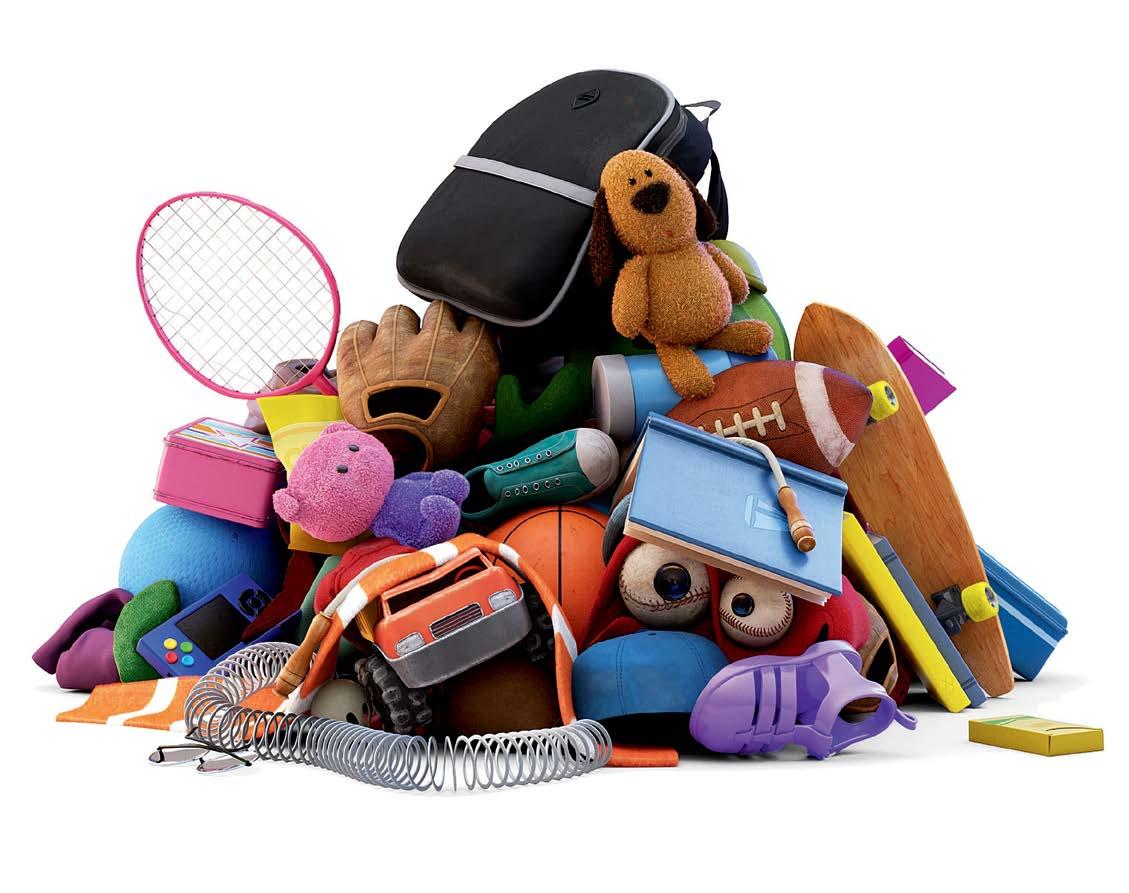
 K. ANDERSON, p.g.a.
MOLINA, MATTHEW ALDRICH STORY BY
UNKRICH, JASON KATZ, MATTHEW ALDRICH, ADRIAN MOLINA
MICHAEL GIACCHINO
& LYRICS BY KRISTEN ANDERSON-LOPEZ AND ROBERT LOPEZ
K. ANDERSON, p.g.a.
MOLINA, MATTHEW ALDRICH STORY BY
UNKRICH, JASON KATZ, MATTHEW ALDRICH, ADRIAN MOLINA
MICHAEL GIACCHINO
& LYRICS BY KRISTEN ANDERSON-LOPEZ AND ROBERT LOPEZ
“Pixar’s ‘Coco’ is another triumph of imagination and sure-footed storytelling, transporting viewers to a vividly-realized world in the service of a universally moving story.” FORBES , Scott Mendelson
ME”